Project Q&D Safe: Analysis and Recommendations for Workplace Safety
VerifiedAdded on 2022/10/12
|26
|5488
|413
Report
AI Summary
This report, titled "Project Q&D Safe," presents a comprehensive analysis of workplace health and safety measures within Q&D Towers, a construction firm recently acquired by UDC. The report, prepared by the National Safety Manager, Rajiv Rachamalla, addresses the critical need to improve Q&D's appalling safety record, characterized by high Lost Time Injury Frequency Rates (LTIFR), excessive insurance premiums, and poor industry performance rankings. The project aims to enhance safety standards through the implementation of a new safety plan, establishment of safety teams, and comprehensive training programs. The business case outlines the project's objectives, rationale, organizational impact, resource implications, and strategic implications, emphasizing the importance of adhering to OSHA regulations. The report includes a detailed project definition, target outcomes, committed outputs, risk assessment, and a Gantt chart, providing a roadmap for improving Q&D's safety performance and aligning it with UDC's successful safety practices. The report emphasizes the need for a proactive approach to workplace safety, focusing on training, equipment, and a strong commitment from management to create a safe and productive working environment.
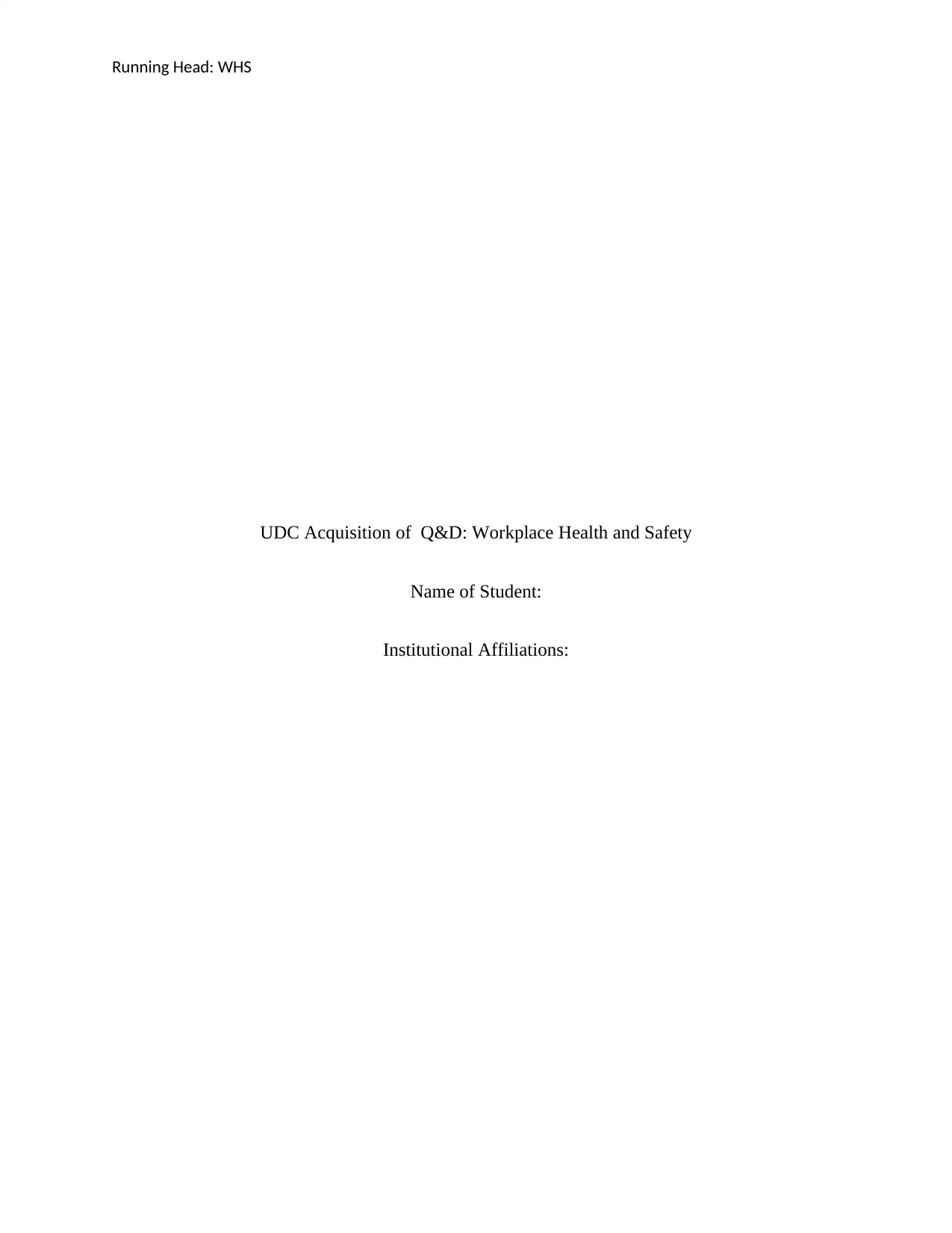
Running Head: WHS
UDC Acquisition of Q&D: Workplace Health and Safety
Name of Student:
Institutional Affiliations:
UDC Acquisition of Q&D: Workplace Health and Safety
Name of Student:
Institutional Affiliations:
Secure Best Marks with AI Grader
Need help grading? Try our AI Grader for instant feedback on your assignments.
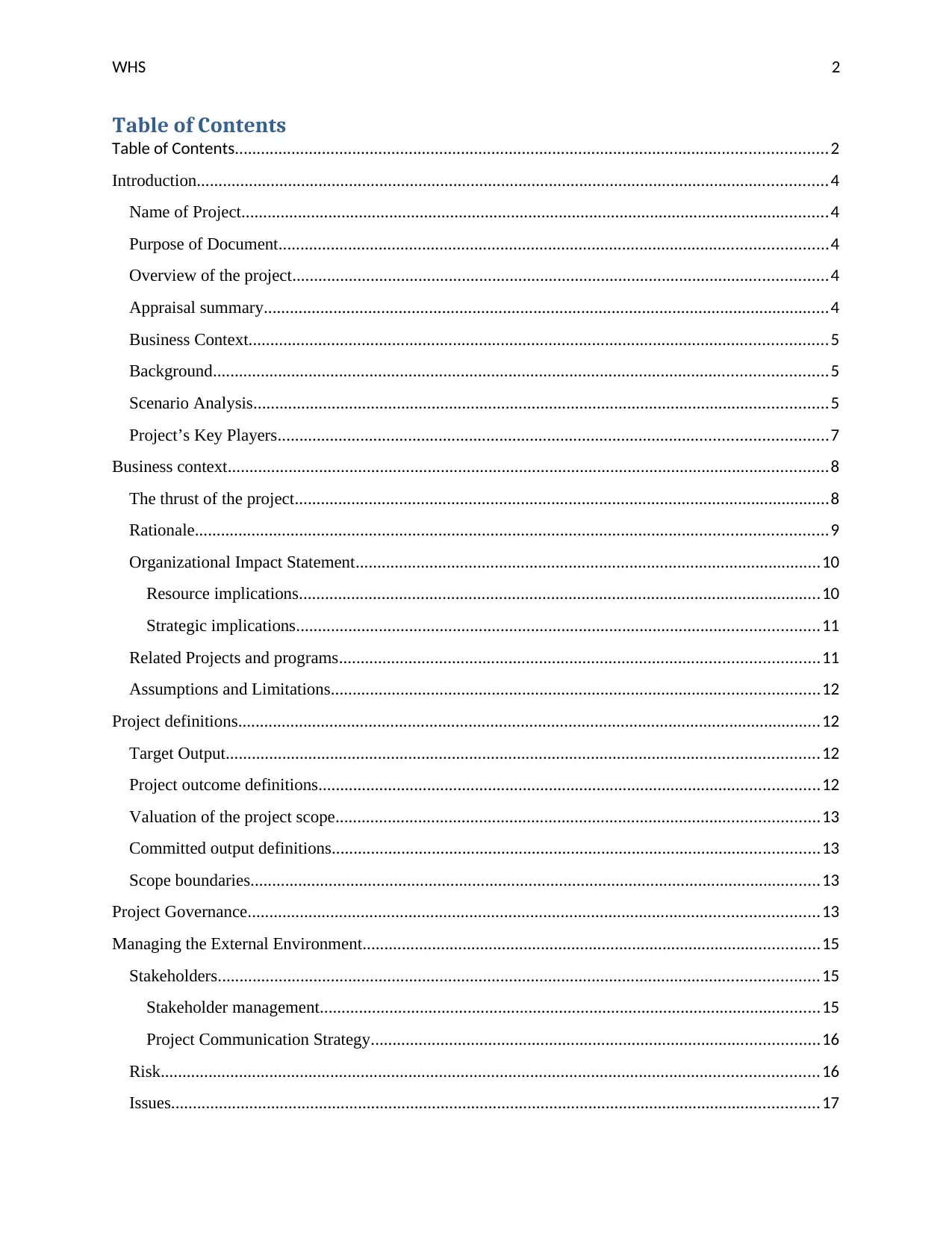
WHS 2
Table of Contents
Table of Contents........................................................................................................................................2
Introduction.................................................................................................................................................4
Name of Project.......................................................................................................................................4
Purpose of Document..............................................................................................................................4
Overview of the project...........................................................................................................................4
Appraisal summary..................................................................................................................................4
Business Context.....................................................................................................................................5
Background.............................................................................................................................................5
Scenario Analysis....................................................................................................................................5
Project’s Key Players..............................................................................................................................7
Business context..........................................................................................................................................8
The thrust of the project...........................................................................................................................8
Rationale.................................................................................................................................................9
Organizational Impact Statement...........................................................................................................10
Resource implications........................................................................................................................10
Strategic implications........................................................................................................................11
Related Projects and programs..............................................................................................................11
Assumptions and Limitations................................................................................................................12
Project definitions......................................................................................................................................12
Target Output........................................................................................................................................12
Project outcome definitions...................................................................................................................12
Valuation of the project scope...............................................................................................................13
Committed output definitions................................................................................................................13
Scope boundaries...................................................................................................................................13
Project Governance...................................................................................................................................13
Managing the External Environment.........................................................................................................15
Stakeholders..........................................................................................................................................15
Stakeholder management...................................................................................................................15
Project Communication Strategy.......................................................................................................16
Risk.......................................................................................................................................................16
Issues.....................................................................................................................................................17
Table of Contents
Table of Contents........................................................................................................................................2
Introduction.................................................................................................................................................4
Name of Project.......................................................................................................................................4
Purpose of Document..............................................................................................................................4
Overview of the project...........................................................................................................................4
Appraisal summary..................................................................................................................................4
Business Context.....................................................................................................................................5
Background.............................................................................................................................................5
Scenario Analysis....................................................................................................................................5
Project’s Key Players..............................................................................................................................7
Business context..........................................................................................................................................8
The thrust of the project...........................................................................................................................8
Rationale.................................................................................................................................................9
Organizational Impact Statement...........................................................................................................10
Resource implications........................................................................................................................10
Strategic implications........................................................................................................................11
Related Projects and programs..............................................................................................................11
Assumptions and Limitations................................................................................................................12
Project definitions......................................................................................................................................12
Target Output........................................................................................................................................12
Project outcome definitions...................................................................................................................12
Valuation of the project scope...............................................................................................................13
Committed output definitions................................................................................................................13
Scope boundaries...................................................................................................................................13
Project Governance...................................................................................................................................13
Managing the External Environment.........................................................................................................15
Stakeholders..........................................................................................................................................15
Stakeholder management...................................................................................................................15
Project Communication Strategy.......................................................................................................16
Risk.......................................................................................................................................................16
Issues.....................................................................................................................................................17
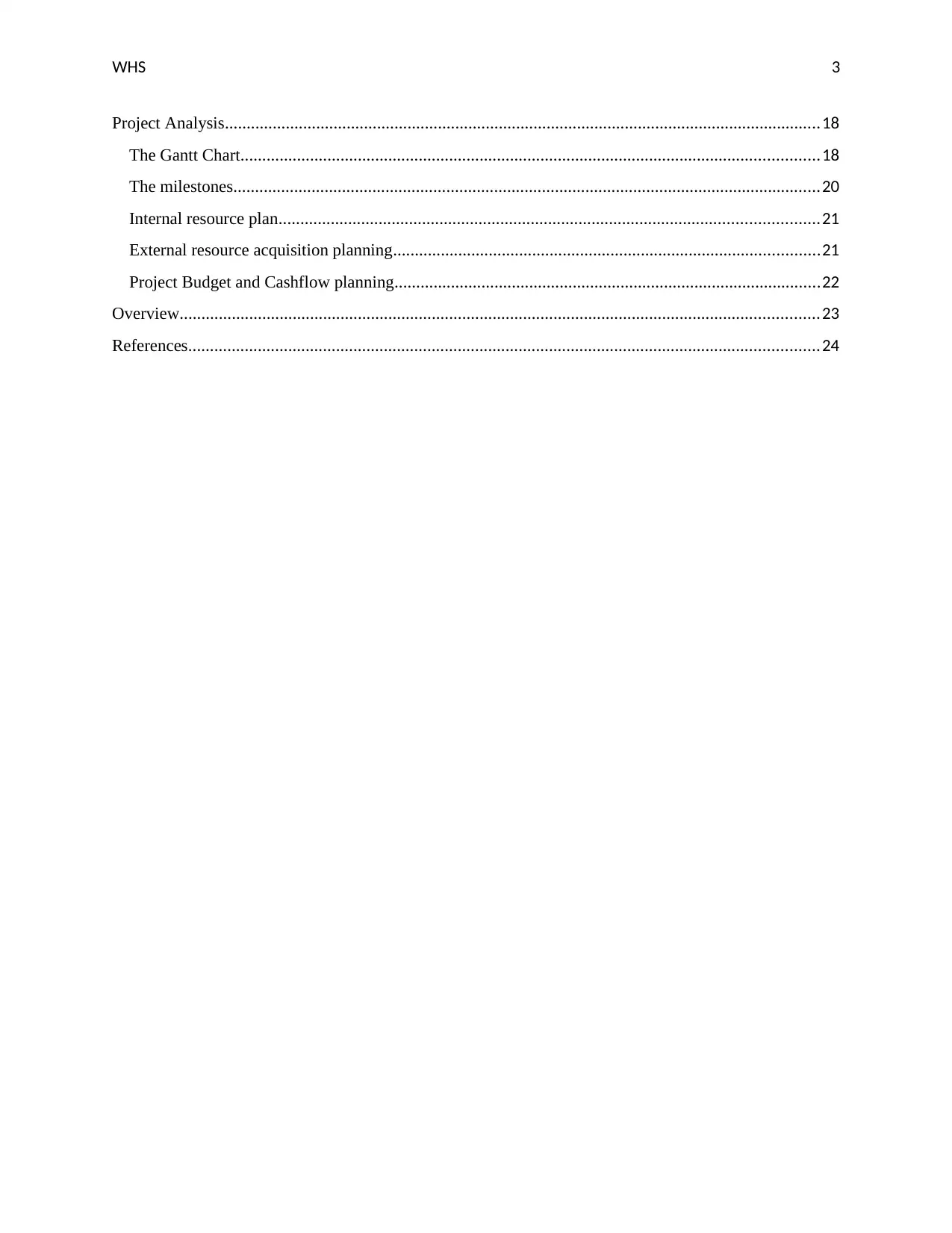
WHS 3
Project Analysis.........................................................................................................................................18
The Gantt Chart.....................................................................................................................................18
The milestones.......................................................................................................................................20
Internal resource plan............................................................................................................................21
External resource acquisition planning..................................................................................................21
Project Budget and Cashflow planning..................................................................................................22
Overview...................................................................................................................................................23
References.................................................................................................................................................24
Project Analysis.........................................................................................................................................18
The Gantt Chart.....................................................................................................................................18
The milestones.......................................................................................................................................20
Internal resource plan............................................................................................................................21
External resource acquisition planning..................................................................................................21
Project Budget and Cashflow planning..................................................................................................22
Overview...................................................................................................................................................23
References.................................................................................................................................................24
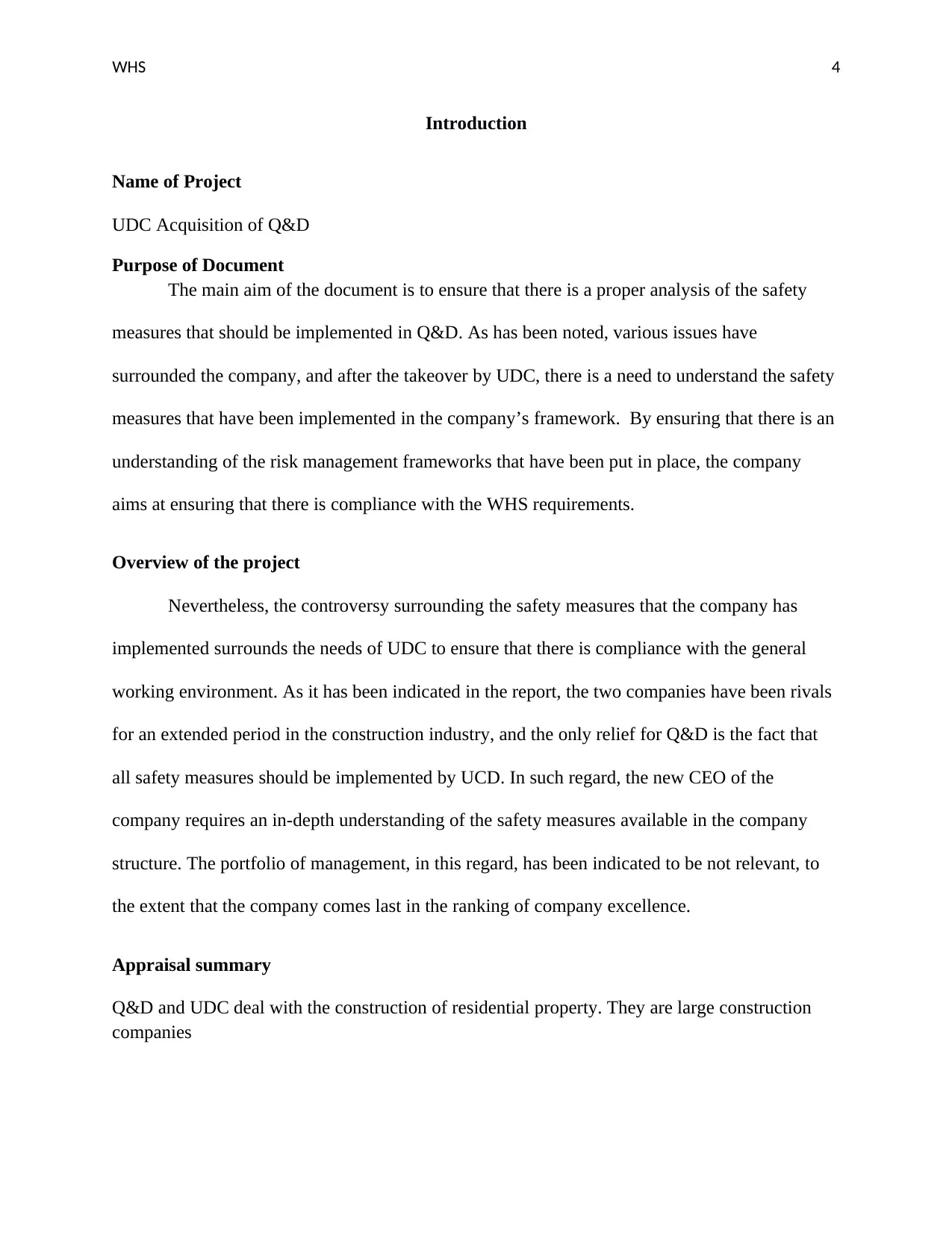
WHS 4
Introduction
Name of Project
UDC Acquisition of Q&D
Purpose of Document
The main aim of the document is to ensure that there is a proper analysis of the safety
measures that should be implemented in Q&D. As has been noted, various issues have
surrounded the company, and after the takeover by UDC, there is a need to understand the safety
measures that have been implemented in the company’s framework. By ensuring that there is an
understanding of the risk management frameworks that have been put in place, the company
aims at ensuring that there is compliance with the WHS requirements.
Overview of the project
Nevertheless, the controversy surrounding the safety measures that the company has
implemented surrounds the needs of UDC to ensure that there is compliance with the general
working environment. As it has been indicated in the report, the two companies have been rivals
for an extended period in the construction industry, and the only relief for Q&D is the fact that
all safety measures should be implemented by UCD. In such regard, the new CEO of the
company requires an in-depth understanding of the safety measures available in the company
structure. The portfolio of management, in this regard, has been indicated to be not relevant, to
the extent that the company comes last in the ranking of company excellence.
Appraisal summary
Q&D and UDC deal with the construction of residential property. They are large construction
companies
Introduction
Name of Project
UDC Acquisition of Q&D
Purpose of Document
The main aim of the document is to ensure that there is a proper analysis of the safety
measures that should be implemented in Q&D. As has been noted, various issues have
surrounded the company, and after the takeover by UDC, there is a need to understand the safety
measures that have been implemented in the company’s framework. By ensuring that there is an
understanding of the risk management frameworks that have been put in place, the company
aims at ensuring that there is compliance with the WHS requirements.
Overview of the project
Nevertheless, the controversy surrounding the safety measures that the company has
implemented surrounds the needs of UDC to ensure that there is compliance with the general
working environment. As it has been indicated in the report, the two companies have been rivals
for an extended period in the construction industry, and the only relief for Q&D is the fact that
all safety measures should be implemented by UCD. In such regard, the new CEO of the
company requires an in-depth understanding of the safety measures available in the company
structure. The portfolio of management, in this regard, has been indicated to be not relevant, to
the extent that the company comes last in the ranking of company excellence.
Appraisal summary
Q&D and UDC deal with the construction of residential property. They are large construction
companies
Secure Best Marks with AI Grader
Need help grading? Try our AI Grader for instant feedback on your assignments.
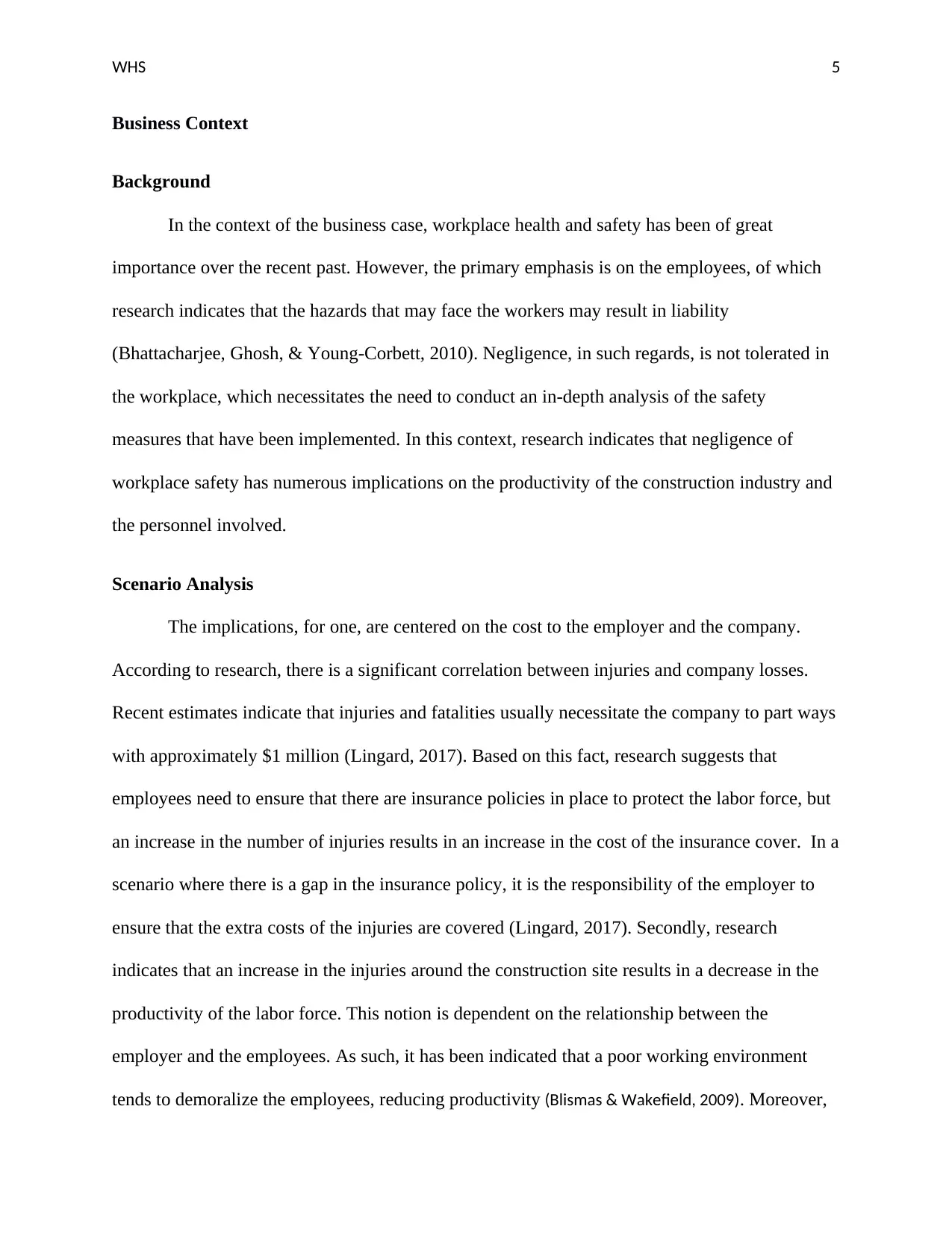
WHS 5
Business Context
Background
In the context of the business case, workplace health and safety has been of great
importance over the recent past. However, the primary emphasis is on the employees, of which
research indicates that the hazards that may face the workers may result in liability
(Bhattacharjee, Ghosh, & Young-Corbett, 2010). Negligence, in such regards, is not tolerated in
the workplace, which necessitates the need to conduct an in-depth analysis of the safety
measures that have been implemented. In this context, research indicates that negligence of
workplace safety has numerous implications on the productivity of the construction industry and
the personnel involved.
Scenario Analysis
The implications, for one, are centered on the cost to the employer and the company.
According to research, there is a significant correlation between injuries and company losses.
Recent estimates indicate that injuries and fatalities usually necessitate the company to part ways
with approximately $1 million (Lingard, 2017). Based on this fact, research suggests that
employees need to ensure that there are insurance policies in place to protect the labor force, but
an increase in the number of injuries results in an increase in the cost of the insurance cover. In a
scenario where there is a gap in the insurance policy, it is the responsibility of the employer to
ensure that the extra costs of the injuries are covered (Lingard, 2017). Secondly, research
indicates that an increase in the injuries around the construction site results in a decrease in the
productivity of the labor force. This notion is dependent on the relationship between the
employer and the employees. As such, it has been indicated that a poor working environment
tends to demoralize the employees, reducing productivity (Blismas & Wakefield, 2009). Moreover,
Business Context
Background
In the context of the business case, workplace health and safety has been of great
importance over the recent past. However, the primary emphasis is on the employees, of which
research indicates that the hazards that may face the workers may result in liability
(Bhattacharjee, Ghosh, & Young-Corbett, 2010). Negligence, in such regards, is not tolerated in
the workplace, which necessitates the need to conduct an in-depth analysis of the safety
measures that have been implemented. In this context, research indicates that negligence of
workplace safety has numerous implications on the productivity of the construction industry and
the personnel involved.
Scenario Analysis
The implications, for one, are centered on the cost to the employer and the company.
According to research, there is a significant correlation between injuries and company losses.
Recent estimates indicate that injuries and fatalities usually necessitate the company to part ways
with approximately $1 million (Lingard, 2017). Based on this fact, research suggests that
employees need to ensure that there are insurance policies in place to protect the labor force, but
an increase in the number of injuries results in an increase in the cost of the insurance cover. In a
scenario where there is a gap in the insurance policy, it is the responsibility of the employer to
ensure that the extra costs of the injuries are covered (Lingard, 2017). Secondly, research
indicates that an increase in the injuries around the construction site results in a decrease in the
productivity of the labor force. This notion is dependent on the relationship between the
employer and the employees. As such, it has been indicated that a poor working environment
tends to demoralize the employees, reducing productivity (Blismas & Wakefield, 2009). Moreover,
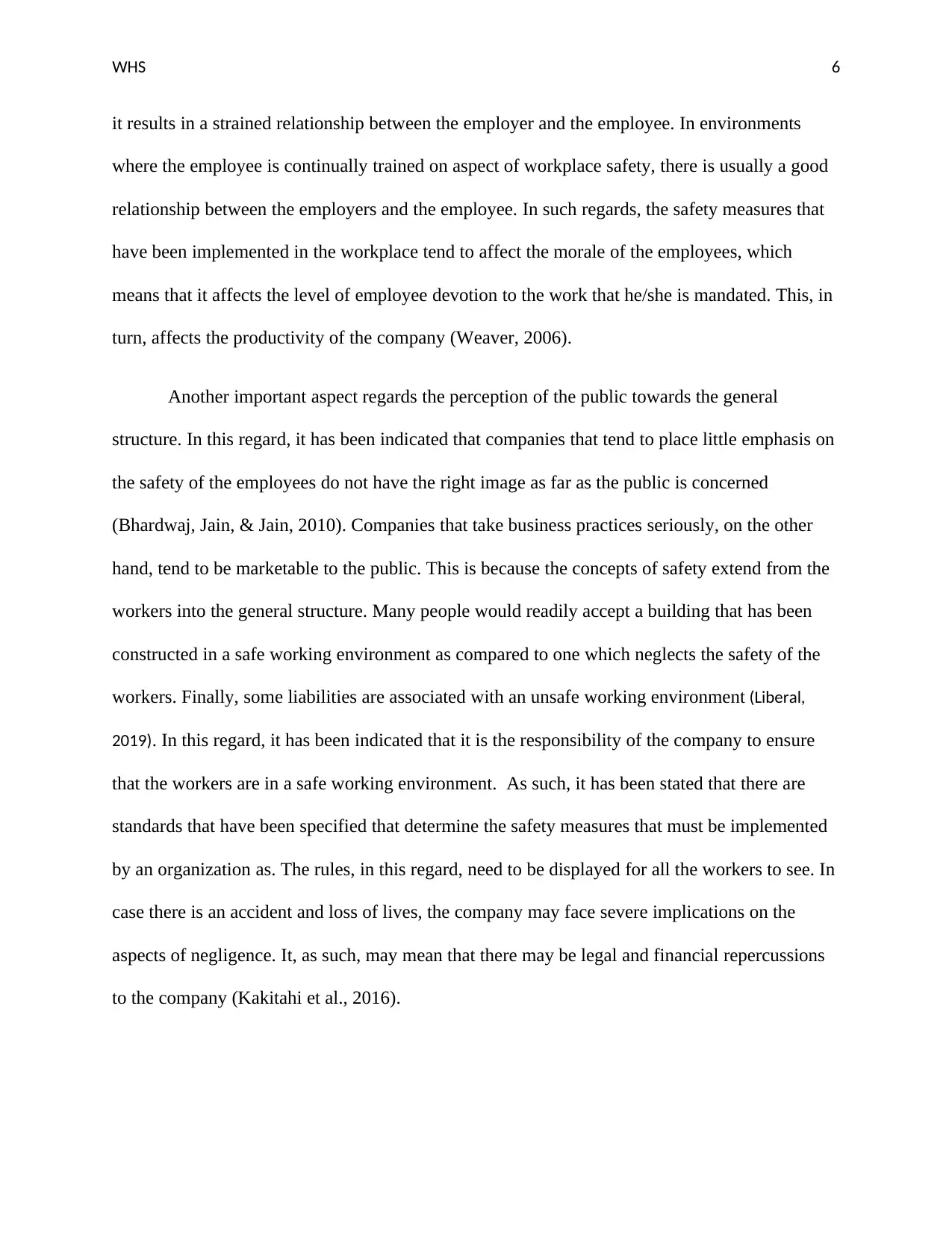
WHS 6
it results in a strained relationship between the employer and the employee. In environments
where the employee is continually trained on aspect of workplace safety, there is usually a good
relationship between the employers and the employee. In such regards, the safety measures that
have been implemented in the workplace tend to affect the morale of the employees, which
means that it affects the level of employee devotion to the work that he/she is mandated. This, in
turn, affects the productivity of the company (Weaver, 2006).
Another important aspect regards the perception of the public towards the general
structure. In this regard, it has been indicated that companies that tend to place little emphasis on
the safety of the employees do not have the right image as far as the public is concerned
(Bhardwaj, Jain, & Jain, 2010). Companies that take business practices seriously, on the other
hand, tend to be marketable to the public. This is because the concepts of safety extend from the
workers into the general structure. Many people would readily accept a building that has been
constructed in a safe working environment as compared to one which neglects the safety of the
workers. Finally, some liabilities are associated with an unsafe working environment (Liberal,
2019). In this regard, it has been indicated that it is the responsibility of the company to ensure
that the workers are in a safe working environment. As such, it has been stated that there are
standards that have been specified that determine the safety measures that must be implemented
by an organization as. The rules, in this regard, need to be displayed for all the workers to see. In
case there is an accident and loss of lives, the company may face severe implications on the
aspects of negligence. It, as such, may mean that there may be legal and financial repercussions
to the company (Kakitahi et al., 2016).
it results in a strained relationship between the employer and the employee. In environments
where the employee is continually trained on aspect of workplace safety, there is usually a good
relationship between the employers and the employee. In such regards, the safety measures that
have been implemented in the workplace tend to affect the morale of the employees, which
means that it affects the level of employee devotion to the work that he/she is mandated. This, in
turn, affects the productivity of the company (Weaver, 2006).
Another important aspect regards the perception of the public towards the general
structure. In this regard, it has been indicated that companies that tend to place little emphasis on
the safety of the employees do not have the right image as far as the public is concerned
(Bhardwaj, Jain, & Jain, 2010). Companies that take business practices seriously, on the other
hand, tend to be marketable to the public. This is because the concepts of safety extend from the
workers into the general structure. Many people would readily accept a building that has been
constructed in a safe working environment as compared to one which neglects the safety of the
workers. Finally, some liabilities are associated with an unsafe working environment (Liberal,
2019). In this regard, it has been indicated that it is the responsibility of the company to ensure
that the workers are in a safe working environment. As such, it has been stated that there are
standards that have been specified that determine the safety measures that must be implemented
by an organization as. The rules, in this regard, need to be displayed for all the workers to see. In
case there is an accident and loss of lives, the company may face severe implications on the
aspects of negligence. It, as such, may mean that there may be legal and financial repercussions
to the company (Kakitahi et al., 2016).
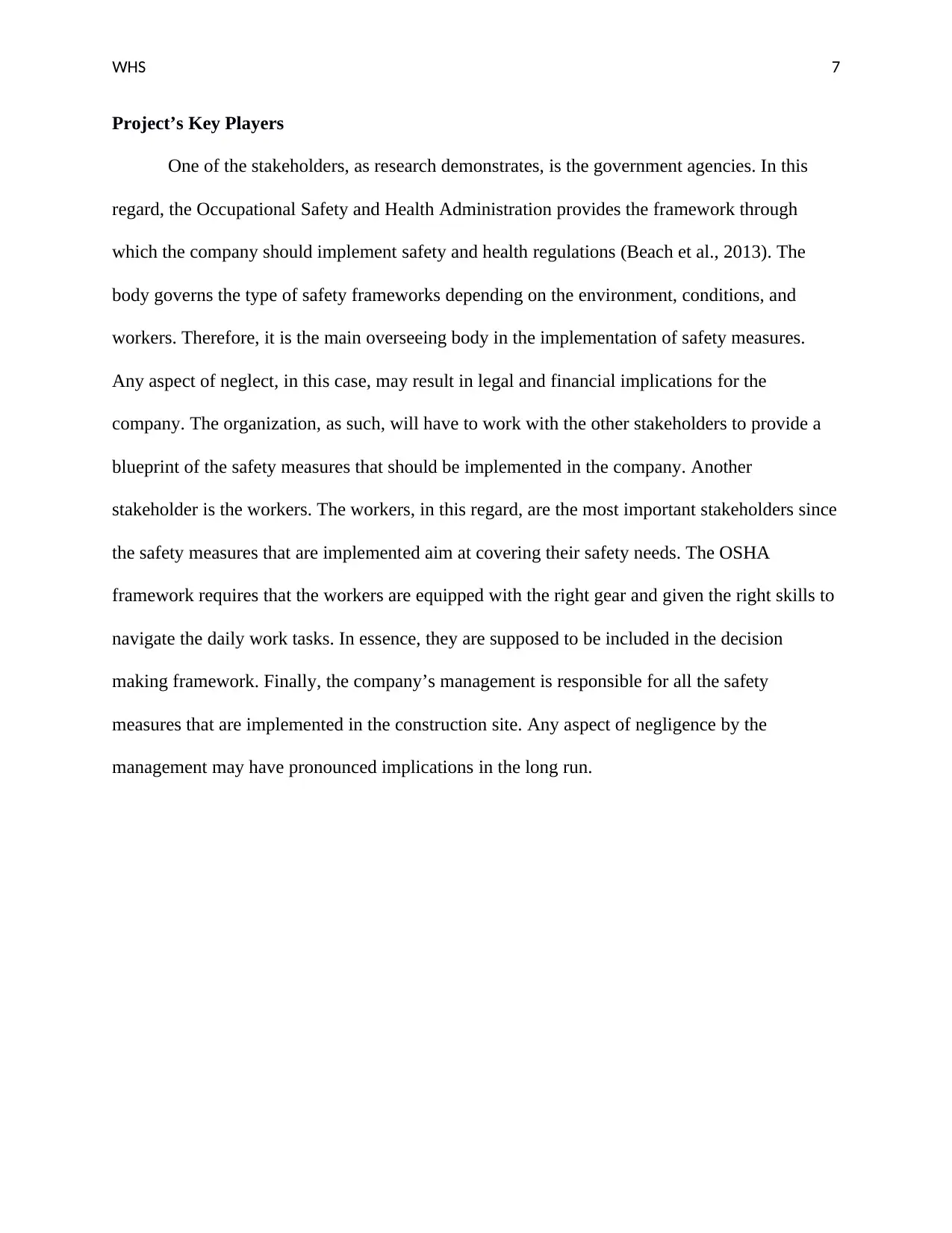
WHS 7
Project’s Key Players
One of the stakeholders, as research demonstrates, is the government agencies. In this
regard, the Occupational Safety and Health Administration provides the framework through
which the company should implement safety and health regulations (Beach et al., 2013). The
body governs the type of safety frameworks depending on the environment, conditions, and
workers. Therefore, it is the main overseeing body in the implementation of safety measures.
Any aspect of neglect, in this case, may result in legal and financial implications for the
company. The organization, as such, will have to work with the other stakeholders to provide a
blueprint of the safety measures that should be implemented in the company. Another
stakeholder is the workers. The workers, in this regard, are the most important stakeholders since
the safety measures that are implemented aim at covering their safety needs. The OSHA
framework requires that the workers are equipped with the right gear and given the right skills to
navigate the daily work tasks. In essence, they are supposed to be included in the decision
making framework. Finally, the company’s management is responsible for all the safety
measures that are implemented in the construction site. Any aspect of negligence by the
management may have pronounced implications in the long run.
Project’s Key Players
One of the stakeholders, as research demonstrates, is the government agencies. In this
regard, the Occupational Safety and Health Administration provides the framework through
which the company should implement safety and health regulations (Beach et al., 2013). The
body governs the type of safety frameworks depending on the environment, conditions, and
workers. Therefore, it is the main overseeing body in the implementation of safety measures.
Any aspect of neglect, in this case, may result in legal and financial implications for the
company. The organization, as such, will have to work with the other stakeholders to provide a
blueprint of the safety measures that should be implemented in the company. Another
stakeholder is the workers. The workers, in this regard, are the most important stakeholders since
the safety measures that are implemented aim at covering their safety needs. The OSHA
framework requires that the workers are equipped with the right gear and given the right skills to
navigate the daily work tasks. In essence, they are supposed to be included in the decision
making framework. Finally, the company’s management is responsible for all the safety
measures that are implemented in the construction site. Any aspect of negligence by the
management may have pronounced implications in the long run.
Paraphrase This Document
Need a fresh take? Get an instant paraphrase of this document with our AI Paraphraser
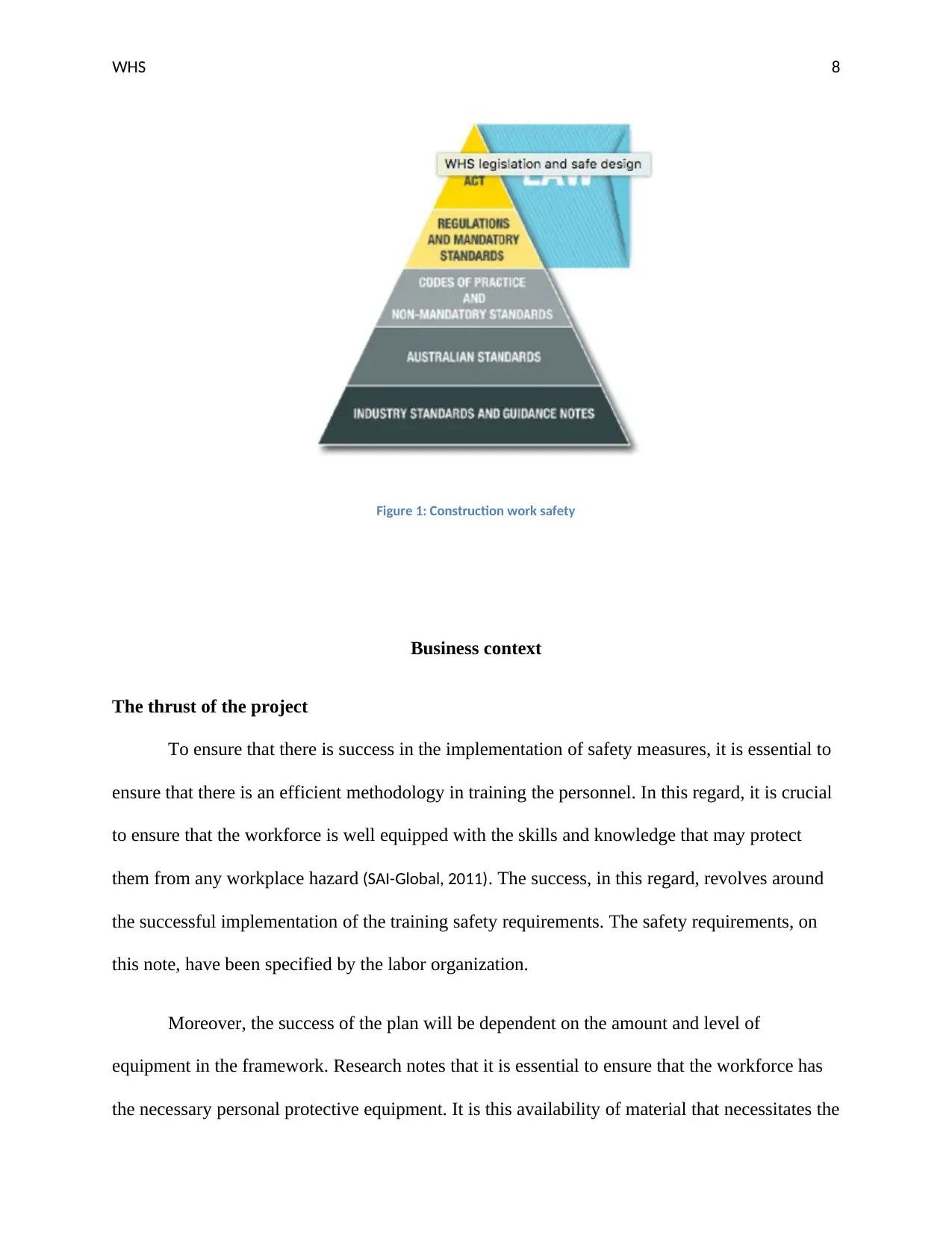
WHS 8
Figure 1: Construction work safety
Business context
The thrust of the project
To ensure that there is success in the implementation of safety measures, it is essential to
ensure that there is an efficient methodology in training the personnel. In this regard, it is crucial
to ensure that the workforce is well equipped with the skills and knowledge that may protect
them from any workplace hazard (SAI-Global, 2011). The success, in this regard, revolves around
the successful implementation of the training safety requirements. The safety requirements, on
this note, have been specified by the labor organization.
Moreover, the success of the plan will be dependent on the amount and level of
equipment in the framework. Research notes that it is essential to ensure that the workforce has
the necessary personal protective equipment. It is this availability of material that necessitates the
Figure 1: Construction work safety
Business context
The thrust of the project
To ensure that there is success in the implementation of safety measures, it is essential to
ensure that there is an efficient methodology in training the personnel. In this regard, it is crucial
to ensure that the workforce is well equipped with the skills and knowledge that may protect
them from any workplace hazard (SAI-Global, 2011). The success, in this regard, revolves around
the successful implementation of the training safety requirements. The safety requirements, on
this note, have been specified by the labor organization.
Moreover, the success of the plan will be dependent on the amount and level of
equipment in the framework. Research notes that it is essential to ensure that the workforce has
the necessary personal protective equipment. It is this availability of material that necessitates the
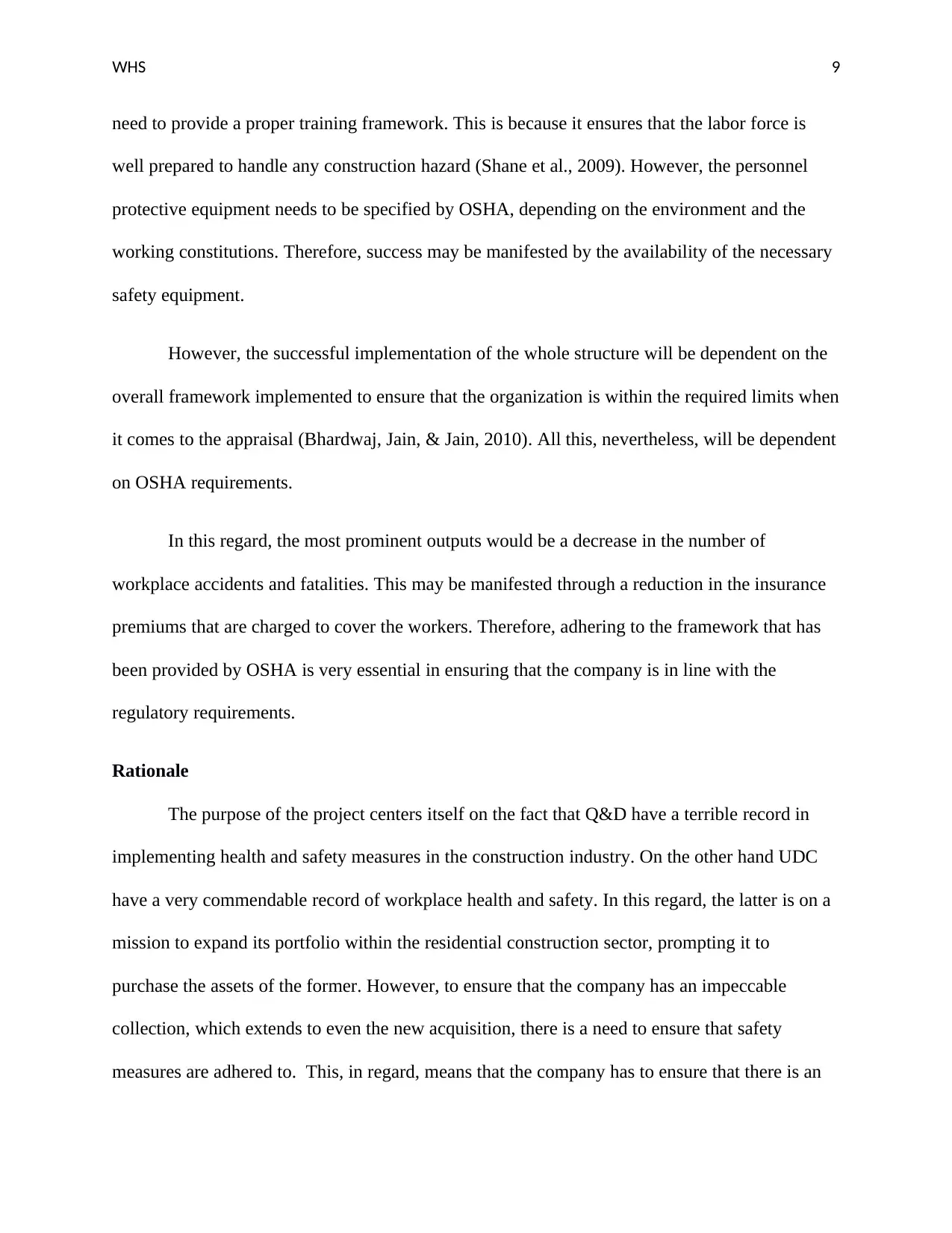
WHS 9
need to provide a proper training framework. This is because it ensures that the labor force is
well prepared to handle any construction hazard (Shane et al., 2009). However, the personnel
protective equipment needs to be specified by OSHA, depending on the environment and the
working constitutions. Therefore, success may be manifested by the availability of the necessary
safety equipment.
However, the successful implementation of the whole structure will be dependent on the
overall framework implemented to ensure that the organization is within the required limits when
it comes to the appraisal (Bhardwaj, Jain, & Jain, 2010). All this, nevertheless, will be dependent
on OSHA requirements.
In this regard, the most prominent outputs would be a decrease in the number of
workplace accidents and fatalities. This may be manifested through a reduction in the insurance
premiums that are charged to cover the workers. Therefore, adhering to the framework that has
been provided by OSHA is very essential in ensuring that the company is in line with the
regulatory requirements.
Rationale
The purpose of the project centers itself on the fact that Q&D have a terrible record in
implementing health and safety measures in the construction industry. On the other hand UDC
have a very commendable record of workplace health and safety. In this regard, the latter is on a
mission to expand its portfolio within the residential construction sector, prompting it to
purchase the assets of the former. However, to ensure that the company has an impeccable
collection, which extends to even the new acquisition, there is a need to ensure that safety
measures are adhered to. This, in regard, means that the company has to ensure that there is an
need to provide a proper training framework. This is because it ensures that the labor force is
well prepared to handle any construction hazard (Shane et al., 2009). However, the personnel
protective equipment needs to be specified by OSHA, depending on the environment and the
working constitutions. Therefore, success may be manifested by the availability of the necessary
safety equipment.
However, the successful implementation of the whole structure will be dependent on the
overall framework implemented to ensure that the organization is within the required limits when
it comes to the appraisal (Bhardwaj, Jain, & Jain, 2010). All this, nevertheless, will be dependent
on OSHA requirements.
In this regard, the most prominent outputs would be a decrease in the number of
workplace accidents and fatalities. This may be manifested through a reduction in the insurance
premiums that are charged to cover the workers. Therefore, adhering to the framework that has
been provided by OSHA is very essential in ensuring that the company is in line with the
regulatory requirements.
Rationale
The purpose of the project centers itself on the fact that Q&D have a terrible record in
implementing health and safety measures in the construction industry. On the other hand UDC
have a very commendable record of workplace health and safety. In this regard, the latter is on a
mission to expand its portfolio within the residential construction sector, prompting it to
purchase the assets of the former. However, to ensure that the company has an impeccable
collection, which extends to even the new acquisition, there is a need to ensure that safety
measures are adhered to. This, in regard, means that the company has to ensure that there is an
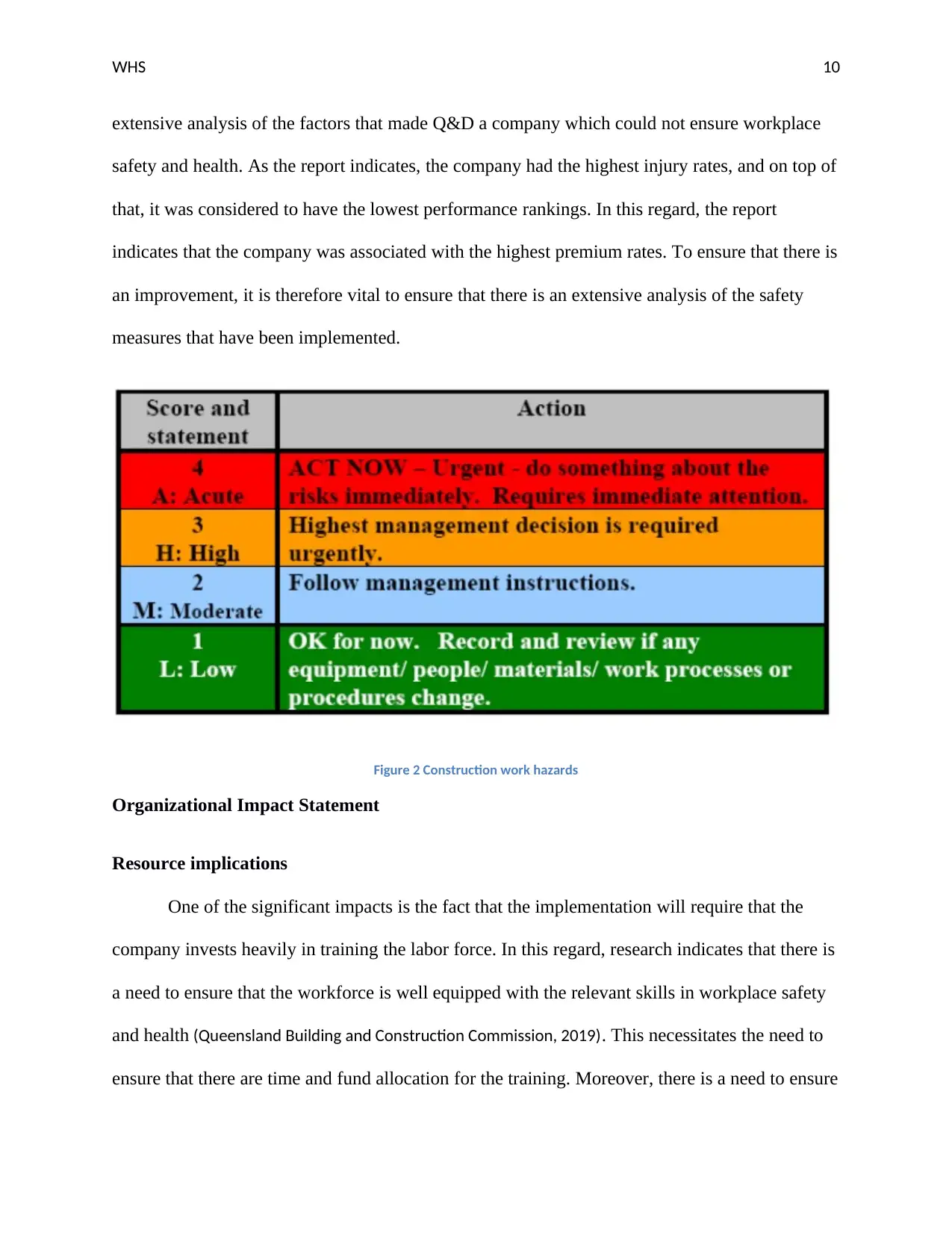
WHS 10
extensive analysis of the factors that made Q&D a company which could not ensure workplace
safety and health. As the report indicates, the company had the highest injury rates, and on top of
that, it was considered to have the lowest performance rankings. In this regard, the report
indicates that the company was associated with the highest premium rates. To ensure that there is
an improvement, it is therefore vital to ensure that there is an extensive analysis of the safety
measures that have been implemented.
Figure 2 Construction work hazards
Organizational Impact Statement
Resource implications
One of the significant impacts is the fact that the implementation will require that the
company invests heavily in training the labor force. In this regard, research indicates that there is
a need to ensure that the workforce is well equipped with the relevant skills in workplace safety
and health (Queensland Building and Construction Commission, 2019). This necessitates the need to
ensure that there are time and fund allocation for the training. Moreover, there is a need to ensure
extensive analysis of the factors that made Q&D a company which could not ensure workplace
safety and health. As the report indicates, the company had the highest injury rates, and on top of
that, it was considered to have the lowest performance rankings. In this regard, the report
indicates that the company was associated with the highest premium rates. To ensure that there is
an improvement, it is therefore vital to ensure that there is an extensive analysis of the safety
measures that have been implemented.
Figure 2 Construction work hazards
Organizational Impact Statement
Resource implications
One of the significant impacts is the fact that the implementation will require that the
company invests heavily in training the labor force. In this regard, research indicates that there is
a need to ensure that the workforce is well equipped with the relevant skills in workplace safety
and health (Queensland Building and Construction Commission, 2019). This necessitates the need to
ensure that there are time and fund allocation for the training. Moreover, there is a need to ensure
Secure Best Marks with AI Grader
Need help grading? Try our AI Grader for instant feedback on your assignments.
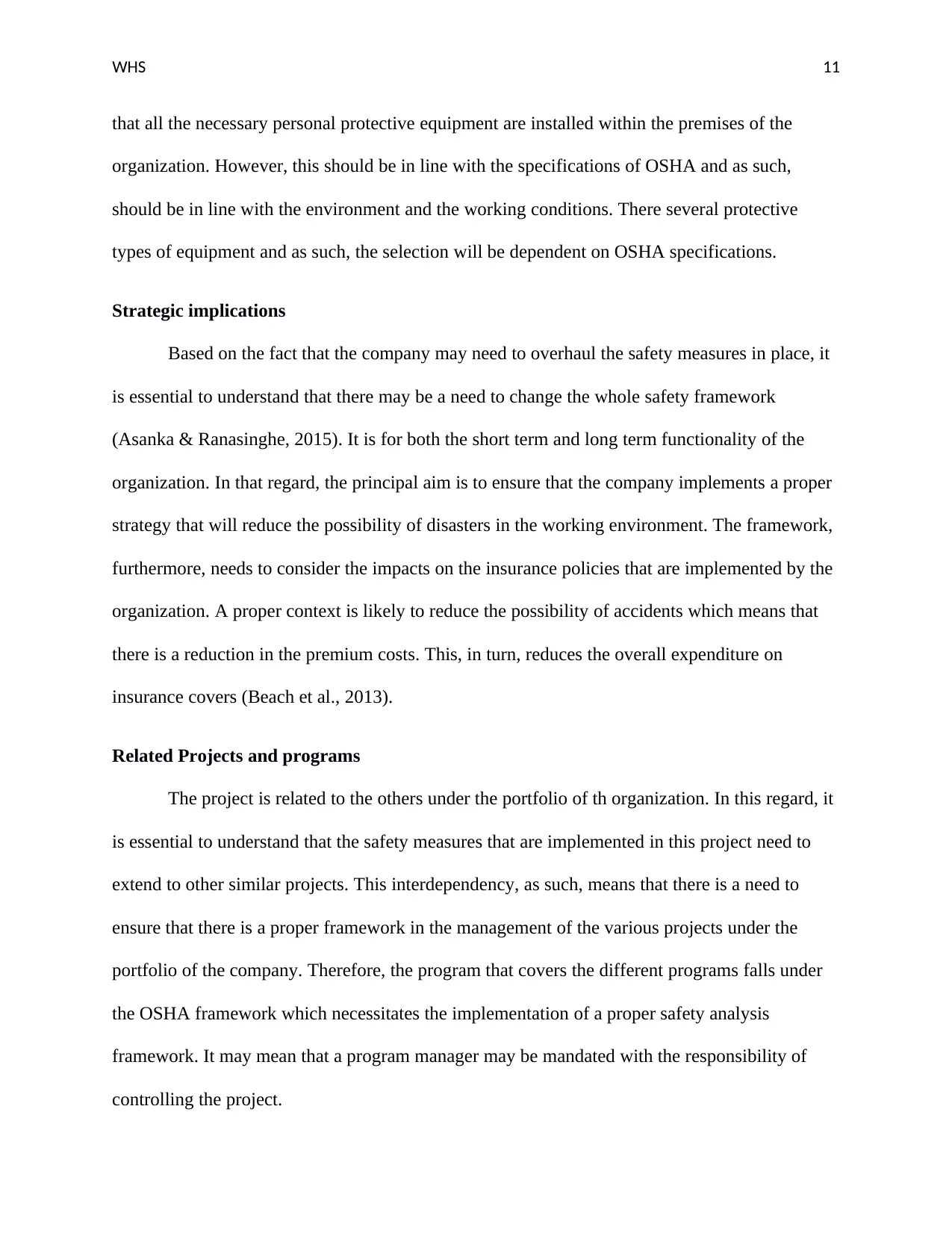
WHS 11
that all the necessary personal protective equipment are installed within the premises of the
organization. However, this should be in line with the specifications of OSHA and as such,
should be in line with the environment and the working conditions. There several protective
types of equipment and as such, the selection will be dependent on OSHA specifications.
Strategic implications
Based on the fact that the company may need to overhaul the safety measures in place, it
is essential to understand that there may be a need to change the whole safety framework
(Asanka & Ranasinghe, 2015). It is for both the short term and long term functionality of the
organization. In that regard, the principal aim is to ensure that the company implements a proper
strategy that will reduce the possibility of disasters in the working environment. The framework,
furthermore, needs to consider the impacts on the insurance policies that are implemented by the
organization. A proper context is likely to reduce the possibility of accidents which means that
there is a reduction in the premium costs. This, in turn, reduces the overall expenditure on
insurance covers (Beach et al., 2013).
Related Projects and programs
The project is related to the others under the portfolio of th organization. In this regard, it
is essential to understand that the safety measures that are implemented in this project need to
extend to other similar projects. This interdependency, as such, means that there is a need to
ensure that there is a proper framework in the management of the various projects under the
portfolio of the company. Therefore, the program that covers the different programs falls under
the OSHA framework which necessitates the implementation of a proper safety analysis
framework. It may mean that a program manager may be mandated with the responsibility of
controlling the project.
that all the necessary personal protective equipment are installed within the premises of the
organization. However, this should be in line with the specifications of OSHA and as such,
should be in line with the environment and the working conditions. There several protective
types of equipment and as such, the selection will be dependent on OSHA specifications.
Strategic implications
Based on the fact that the company may need to overhaul the safety measures in place, it
is essential to understand that there may be a need to change the whole safety framework
(Asanka & Ranasinghe, 2015). It is for both the short term and long term functionality of the
organization. In that regard, the principal aim is to ensure that the company implements a proper
strategy that will reduce the possibility of disasters in the working environment. The framework,
furthermore, needs to consider the impacts on the insurance policies that are implemented by the
organization. A proper context is likely to reduce the possibility of accidents which means that
there is a reduction in the premium costs. This, in turn, reduces the overall expenditure on
insurance covers (Beach et al., 2013).
Related Projects and programs
The project is related to the others under the portfolio of th organization. In this regard, it
is essential to understand that the safety measures that are implemented in this project need to
extend to other similar projects. This interdependency, as such, means that there is a need to
ensure that there is a proper framework in the management of the various projects under the
portfolio of the company. Therefore, the program that covers the different programs falls under
the OSHA framework which necessitates the implementation of a proper safety analysis
framework. It may mean that a program manager may be mandated with the responsibility of
controlling the project.
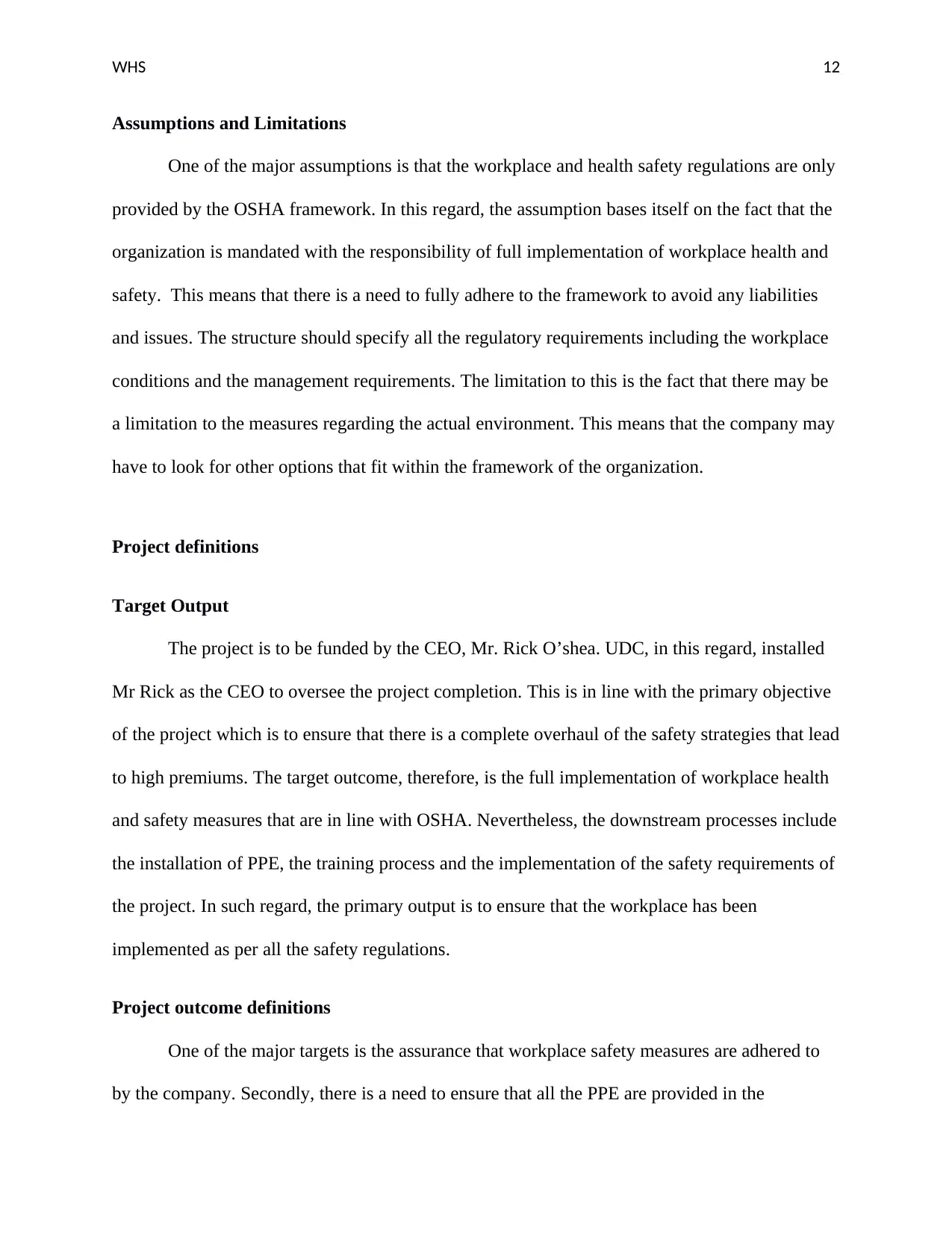
WHS 12
Assumptions and Limitations
One of the major assumptions is that the workplace and health safety regulations are only
provided by the OSHA framework. In this regard, the assumption bases itself on the fact that the
organization is mandated with the responsibility of full implementation of workplace health and
safety. This means that there is a need to fully adhere to the framework to avoid any liabilities
and issues. The structure should specify all the regulatory requirements including the workplace
conditions and the management requirements. The limitation to this is the fact that there may be
a limitation to the measures regarding the actual environment. This means that the company may
have to look for other options that fit within the framework of the organization.
Project definitions
Target Output
The project is to be funded by the CEO, Mr. Rick O’shea. UDC, in this regard, installed
Mr Rick as the CEO to oversee the project completion. This is in line with the primary objective
of the project which is to ensure that there is a complete overhaul of the safety strategies that lead
to high premiums. The target outcome, therefore, is the full implementation of workplace health
and safety measures that are in line with OSHA. Nevertheless, the downstream processes include
the installation of PPE, the training process and the implementation of the safety requirements of
the project. In such regard, the primary output is to ensure that the workplace has been
implemented as per all the safety regulations.
Project outcome definitions
One of the major targets is the assurance that workplace safety measures are adhered to
by the company. Secondly, there is a need to ensure that all the PPE are provided in the
Assumptions and Limitations
One of the major assumptions is that the workplace and health safety regulations are only
provided by the OSHA framework. In this regard, the assumption bases itself on the fact that the
organization is mandated with the responsibility of full implementation of workplace health and
safety. This means that there is a need to fully adhere to the framework to avoid any liabilities
and issues. The structure should specify all the regulatory requirements including the workplace
conditions and the management requirements. The limitation to this is the fact that there may be
a limitation to the measures regarding the actual environment. This means that the company may
have to look for other options that fit within the framework of the organization.
Project definitions
Target Output
The project is to be funded by the CEO, Mr. Rick O’shea. UDC, in this regard, installed
Mr Rick as the CEO to oversee the project completion. This is in line with the primary objective
of the project which is to ensure that there is a complete overhaul of the safety strategies that lead
to high premiums. The target outcome, therefore, is the full implementation of workplace health
and safety measures that are in line with OSHA. Nevertheless, the downstream processes include
the installation of PPE, the training process and the implementation of the safety requirements of
the project. In such regard, the primary output is to ensure that the workplace has been
implemented as per all the safety regulations.
Project outcome definitions
One of the major targets is the assurance that workplace safety measures are adhered to
by the company. Secondly, there is a need to ensure that all the PPE are provided in the
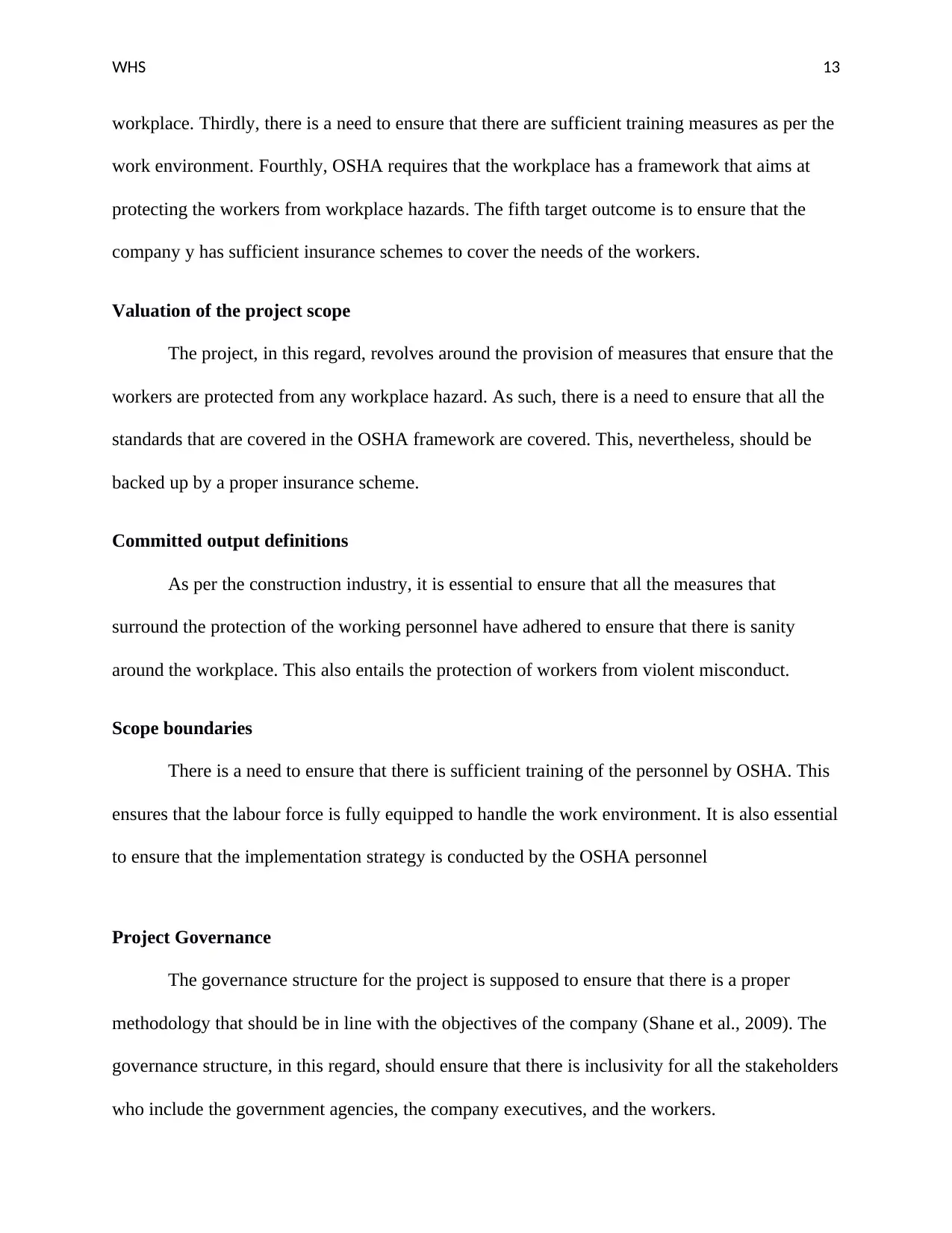
WHS 13
workplace. Thirdly, there is a need to ensure that there are sufficient training measures as per the
work environment. Fourthly, OSHA requires that the workplace has a framework that aims at
protecting the workers from workplace hazards. The fifth target outcome is to ensure that the
company y has sufficient insurance schemes to cover the needs of the workers.
Valuation of the project scope
The project, in this regard, revolves around the provision of measures that ensure that the
workers are protected from any workplace hazard. As such, there is a need to ensure that all the
standards that are covered in the OSHA framework are covered. This, nevertheless, should be
backed up by a proper insurance scheme.
Committed output definitions
As per the construction industry, it is essential to ensure that all the measures that
surround the protection of the working personnel have adhered to ensure that there is sanity
around the workplace. This also entails the protection of workers from violent misconduct.
Scope boundaries
There is a need to ensure that there is sufficient training of the personnel by OSHA. This
ensures that the labour force is fully equipped to handle the work environment. It is also essential
to ensure that the implementation strategy is conducted by the OSHA personnel
Project Governance
The governance structure for the project is supposed to ensure that there is a proper
methodology that should be in line with the objectives of the company (Shane et al., 2009). The
governance structure, in this regard, should ensure that there is inclusivity for all the stakeholders
who include the government agencies, the company executives, and the workers.
workplace. Thirdly, there is a need to ensure that there are sufficient training measures as per the
work environment. Fourthly, OSHA requires that the workplace has a framework that aims at
protecting the workers from workplace hazards. The fifth target outcome is to ensure that the
company y has sufficient insurance schemes to cover the needs of the workers.
Valuation of the project scope
The project, in this regard, revolves around the provision of measures that ensure that the
workers are protected from any workplace hazard. As such, there is a need to ensure that all the
standards that are covered in the OSHA framework are covered. This, nevertheless, should be
backed up by a proper insurance scheme.
Committed output definitions
As per the construction industry, it is essential to ensure that all the measures that
surround the protection of the working personnel have adhered to ensure that there is sanity
around the workplace. This also entails the protection of workers from violent misconduct.
Scope boundaries
There is a need to ensure that there is sufficient training of the personnel by OSHA. This
ensures that the labour force is fully equipped to handle the work environment. It is also essential
to ensure that the implementation strategy is conducted by the OSHA personnel
Project Governance
The governance structure for the project is supposed to ensure that there is a proper
methodology that should be in line with the objectives of the company (Shane et al., 2009). The
governance structure, in this regard, should ensure that there is inclusivity for all the stakeholders
who include the government agencies, the company executives, and the workers.
Paraphrase This Document
Need a fresh take? Get an instant paraphrase of this document with our AI Paraphraser
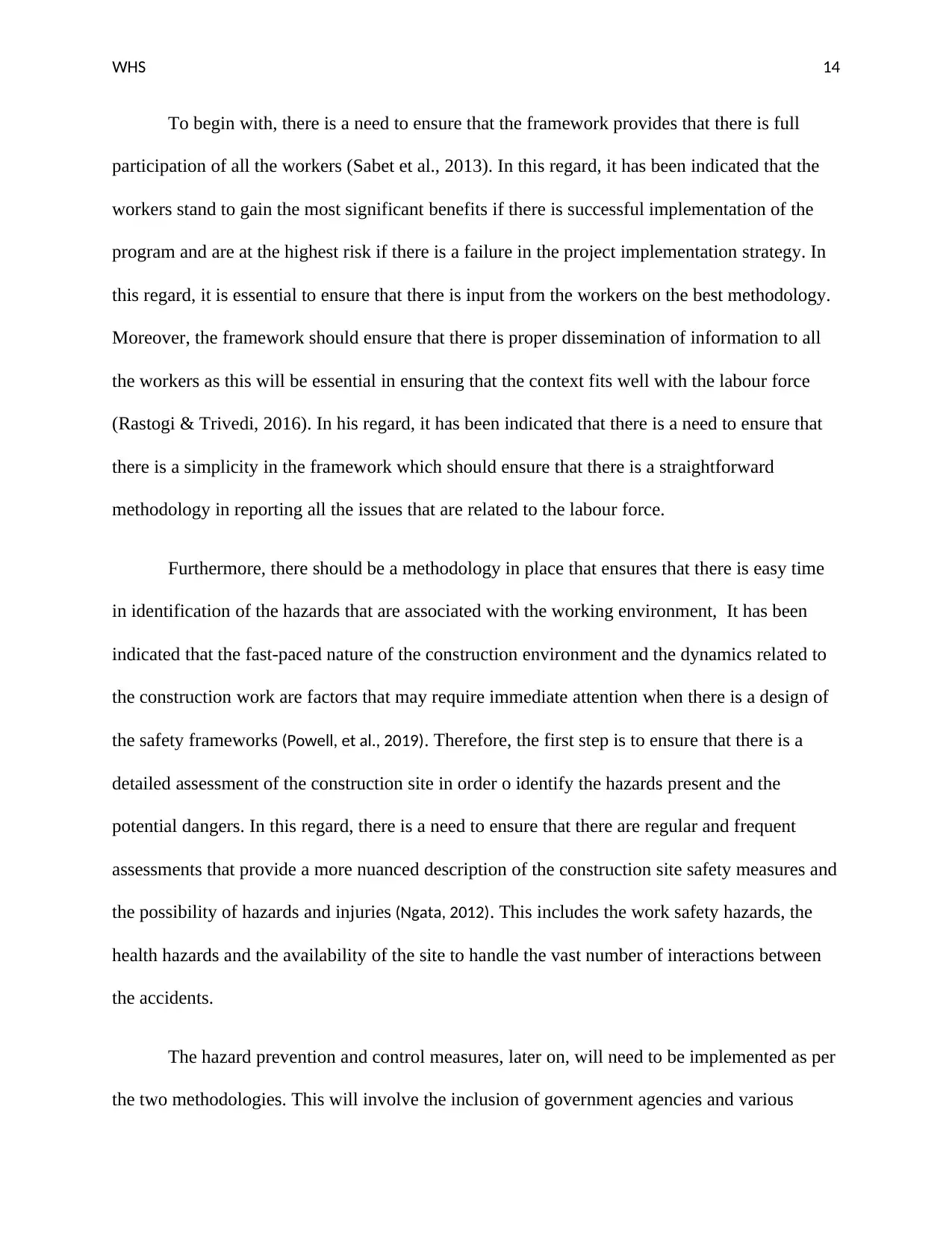
WHS 14
To begin with, there is a need to ensure that the framework provides that there is full
participation of all the workers (Sabet et al., 2013). In this regard, it has been indicated that the
workers stand to gain the most significant benefits if there is successful implementation of the
program and are at the highest risk if there is a failure in the project implementation strategy. In
this regard, it is essential to ensure that there is input from the workers on the best methodology.
Moreover, the framework should ensure that there is proper dissemination of information to all
the workers as this will be essential in ensuring that the context fits well with the labour force
(Rastogi & Trivedi, 2016). In his regard, it has been indicated that there is a need to ensure that
there is a simplicity in the framework which should ensure that there is a straightforward
methodology in reporting all the issues that are related to the labour force.
Furthermore, there should be a methodology in place that ensures that there is easy time
in identification of the hazards that are associated with the working environment, It has been
indicated that the fast-paced nature of the construction environment and the dynamics related to
the construction work are factors that may require immediate attention when there is a design of
the safety frameworks (Powell, et al., 2019). Therefore, the first step is to ensure that there is a
detailed assessment of the construction site in order o identify the hazards present and the
potential dangers. In this regard, there is a need to ensure that there are regular and frequent
assessments that provide a more nuanced description of the construction site safety measures and
the possibility of hazards and injuries (Ngata, 2012). This includes the work safety hazards, the
health hazards and the availability of the site to handle the vast number of interactions between
the accidents.
The hazard prevention and control measures, later on, will need to be implemented as per
the two methodologies. This will involve the inclusion of government agencies and various
To begin with, there is a need to ensure that the framework provides that there is full
participation of all the workers (Sabet et al., 2013). In this regard, it has been indicated that the
workers stand to gain the most significant benefits if there is successful implementation of the
program and are at the highest risk if there is a failure in the project implementation strategy. In
this regard, it is essential to ensure that there is input from the workers on the best methodology.
Moreover, the framework should ensure that there is proper dissemination of information to all
the workers as this will be essential in ensuring that the context fits well with the labour force
(Rastogi & Trivedi, 2016). In his regard, it has been indicated that there is a need to ensure that
there is a simplicity in the framework which should ensure that there is a straightforward
methodology in reporting all the issues that are related to the labour force.
Furthermore, there should be a methodology in place that ensures that there is easy time
in identification of the hazards that are associated with the working environment, It has been
indicated that the fast-paced nature of the construction environment and the dynamics related to
the construction work are factors that may require immediate attention when there is a design of
the safety frameworks (Powell, et al., 2019). Therefore, the first step is to ensure that there is a
detailed assessment of the construction site in order o identify the hazards present and the
potential dangers. In this regard, there is a need to ensure that there are regular and frequent
assessments that provide a more nuanced description of the construction site safety measures and
the possibility of hazards and injuries (Ngata, 2012). This includes the work safety hazards, the
health hazards and the availability of the site to handle the vast number of interactions between
the accidents.
The hazard prevention and control measures, later on, will need to be implemented as per
the two methodologies. This will involve the inclusion of government agencies and various
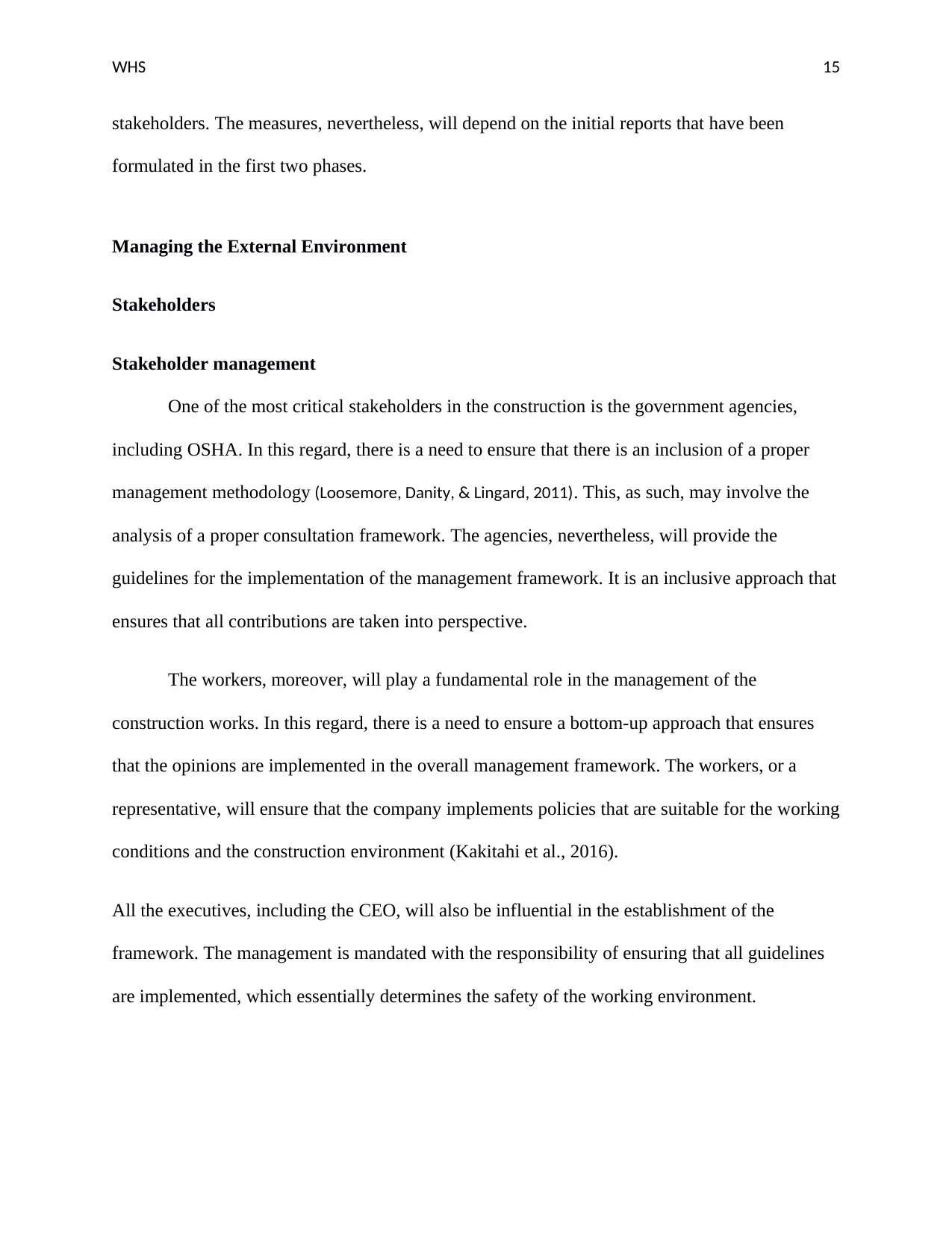
WHS 15
stakeholders. The measures, nevertheless, will depend on the initial reports that have been
formulated in the first two phases.
Managing the External Environment
Stakeholders
Stakeholder management
One of the most critical stakeholders in the construction is the government agencies,
including OSHA. In this regard, there is a need to ensure that there is an inclusion of a proper
management methodology (Loosemore, Danity, & Lingard, 2011). This, as such, may involve the
analysis of a proper consultation framework. The agencies, nevertheless, will provide the
guidelines for the implementation of the management framework. It is an inclusive approach that
ensures that all contributions are taken into perspective.
The workers, moreover, will play a fundamental role in the management of the
construction works. In this regard, there is a need to ensure a bottom-up approach that ensures
that the opinions are implemented in the overall management framework. The workers, or a
representative, will ensure that the company implements policies that are suitable for the working
conditions and the construction environment (Kakitahi et al., 2016).
All the executives, including the CEO, will also be influential in the establishment of the
framework. The management is mandated with the responsibility of ensuring that all guidelines
are implemented, which essentially determines the safety of the working environment.
stakeholders. The measures, nevertheless, will depend on the initial reports that have been
formulated in the first two phases.
Managing the External Environment
Stakeholders
Stakeholder management
One of the most critical stakeholders in the construction is the government agencies,
including OSHA. In this regard, there is a need to ensure that there is an inclusion of a proper
management methodology (Loosemore, Danity, & Lingard, 2011). This, as such, may involve the
analysis of a proper consultation framework. The agencies, nevertheless, will provide the
guidelines for the implementation of the management framework. It is an inclusive approach that
ensures that all contributions are taken into perspective.
The workers, moreover, will play a fundamental role in the management of the
construction works. In this regard, there is a need to ensure a bottom-up approach that ensures
that the opinions are implemented in the overall management framework. The workers, or a
representative, will ensure that the company implements policies that are suitable for the working
conditions and the construction environment (Kakitahi et al., 2016).
All the executives, including the CEO, will also be influential in the establishment of the
framework. The management is mandated with the responsibility of ensuring that all guidelines
are implemented, which essentially determines the safety of the working environment.
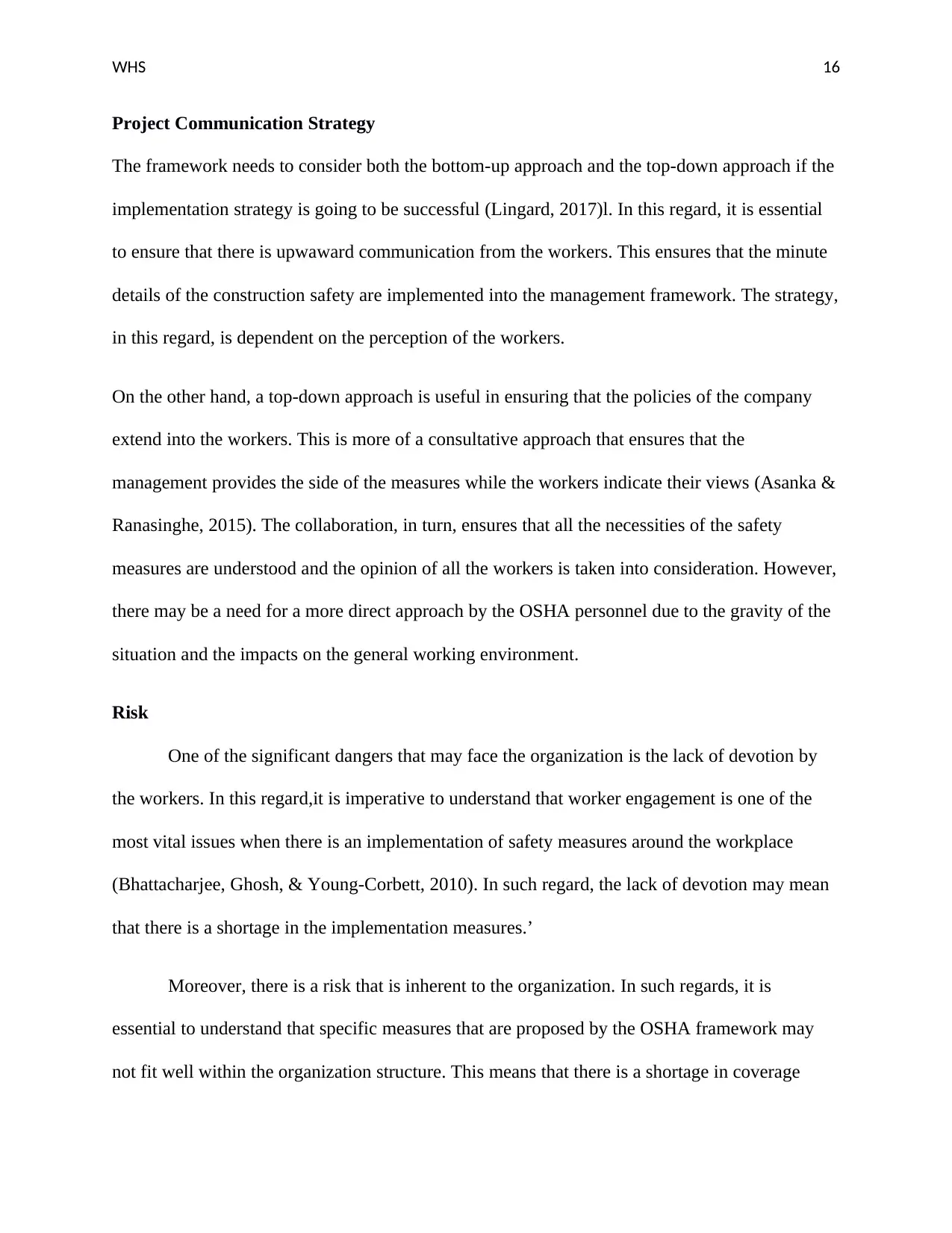
WHS 16
Project Communication Strategy
The framework needs to consider both the bottom-up approach and the top-down approach if the
implementation strategy is going to be successful (Lingard, 2017)l. In this regard, it is essential
to ensure that there is upwaward communication from the workers. This ensures that the minute
details of the construction safety are implemented into the management framework. The strategy,
in this regard, is dependent on the perception of the workers.
On the other hand, a top-down approach is useful in ensuring that the policies of the company
extend into the workers. This is more of a consultative approach that ensures that the
management provides the side of the measures while the workers indicate their views (Asanka &
Ranasinghe, 2015). The collaboration, in turn, ensures that all the necessities of the safety
measures are understood and the opinion of all the workers is taken into consideration. However,
there may be a need for a more direct approach by the OSHA personnel due to the gravity of the
situation and the impacts on the general working environment.
Risk
One of the significant dangers that may face the organization is the lack of devotion by
the workers. In this regard,it is imperative to understand that worker engagement is one of the
most vital issues when there is an implementation of safety measures around the workplace
(Bhattacharjee, Ghosh, & Young-Corbett, 2010). In such regard, the lack of devotion may mean
that there is a shortage in the implementation measures.’
Moreover, there is a risk that is inherent to the organization. In such regards, it is
essential to understand that specific measures that are proposed by the OSHA framework may
not fit well within the organization structure. This means that there is a shortage in coverage
Project Communication Strategy
The framework needs to consider both the bottom-up approach and the top-down approach if the
implementation strategy is going to be successful (Lingard, 2017)l. In this regard, it is essential
to ensure that there is upwaward communication from the workers. This ensures that the minute
details of the construction safety are implemented into the management framework. The strategy,
in this regard, is dependent on the perception of the workers.
On the other hand, a top-down approach is useful in ensuring that the policies of the company
extend into the workers. This is more of a consultative approach that ensures that the
management provides the side of the measures while the workers indicate their views (Asanka &
Ranasinghe, 2015). The collaboration, in turn, ensures that all the necessities of the safety
measures are understood and the opinion of all the workers is taken into consideration. However,
there may be a need for a more direct approach by the OSHA personnel due to the gravity of the
situation and the impacts on the general working environment.
Risk
One of the significant dangers that may face the organization is the lack of devotion by
the workers. In this regard,it is imperative to understand that worker engagement is one of the
most vital issues when there is an implementation of safety measures around the workplace
(Bhattacharjee, Ghosh, & Young-Corbett, 2010). In such regard, the lack of devotion may mean
that there is a shortage in the implementation measures.’
Moreover, there is a risk that is inherent to the organization. In such regards, it is
essential to understand that specific measures that are proposed by the OSHA framework may
not fit well within the organization structure. This means that there is a shortage in coverage
Secure Best Marks with AI Grader
Need help grading? Try our AI Grader for instant feedback on your assignments.
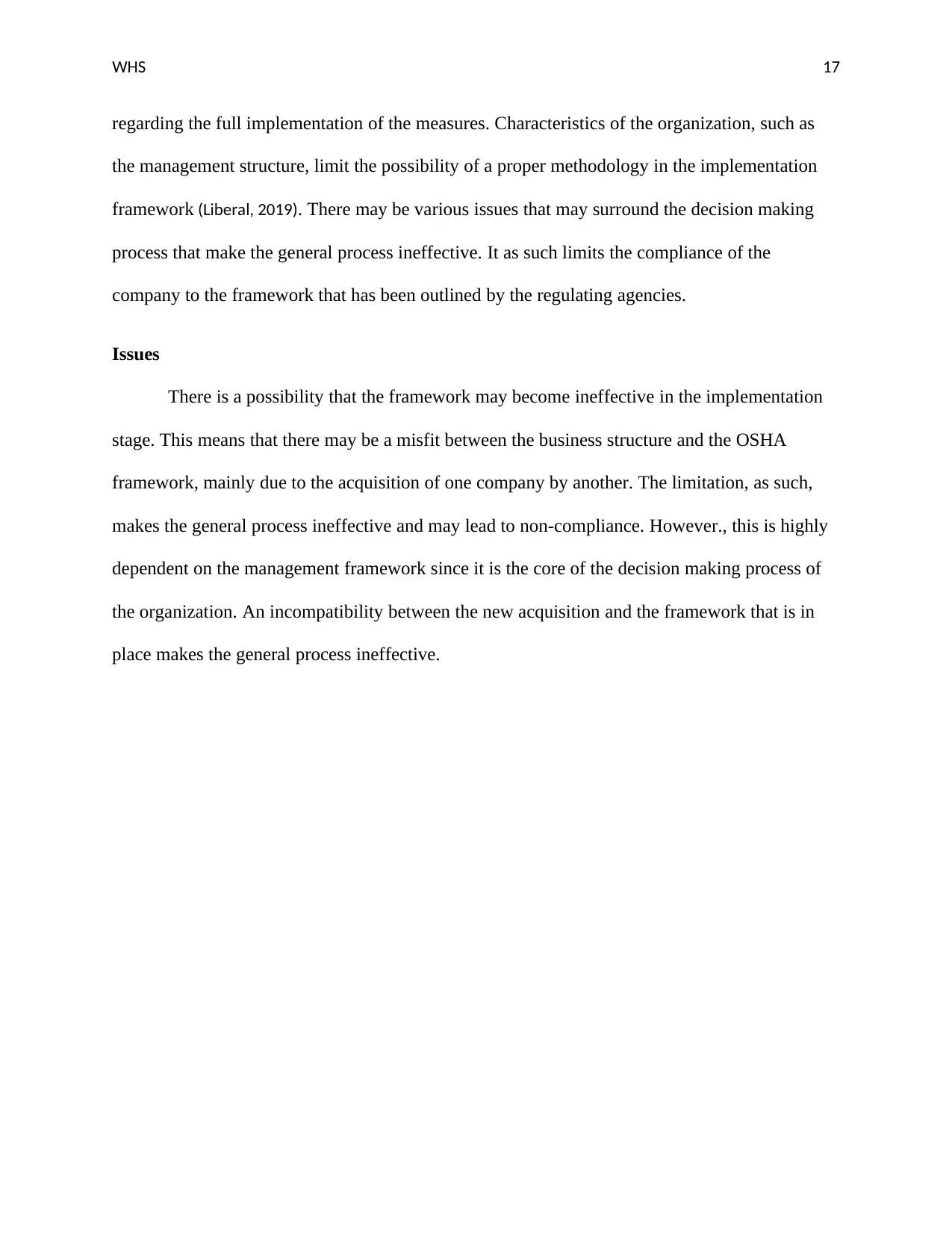
WHS 17
regarding the full implementation of the measures. Characteristics of the organization, such as
the management structure, limit the possibility of a proper methodology in the implementation
framework (Liberal, 2019). There may be various issues that may surround the decision making
process that make the general process ineffective. It as such limits the compliance of the
company to the framework that has been outlined by the regulating agencies.
Issues
There is a possibility that the framework may become ineffective in the implementation
stage. This means that there may be a misfit between the business structure and the OSHA
framework, mainly due to the acquisition of one company by another. The limitation, as such,
makes the general process ineffective and may lead to non-compliance. However., this is highly
dependent on the management framework since it is the core of the decision making process of
the organization. An incompatibility between the new acquisition and the framework that is in
place makes the general process ineffective.
regarding the full implementation of the measures. Characteristics of the organization, such as
the management structure, limit the possibility of a proper methodology in the implementation
framework (Liberal, 2019). There may be various issues that may surround the decision making
process that make the general process ineffective. It as such limits the compliance of the
company to the framework that has been outlined by the regulating agencies.
Issues
There is a possibility that the framework may become ineffective in the implementation
stage. This means that there may be a misfit between the business structure and the OSHA
framework, mainly due to the acquisition of one company by another. The limitation, as such,
makes the general process ineffective and may lead to non-compliance. However., this is highly
dependent on the management framework since it is the core of the decision making process of
the organization. An incompatibility between the new acquisition and the framework that is in
place makes the general process ineffective.
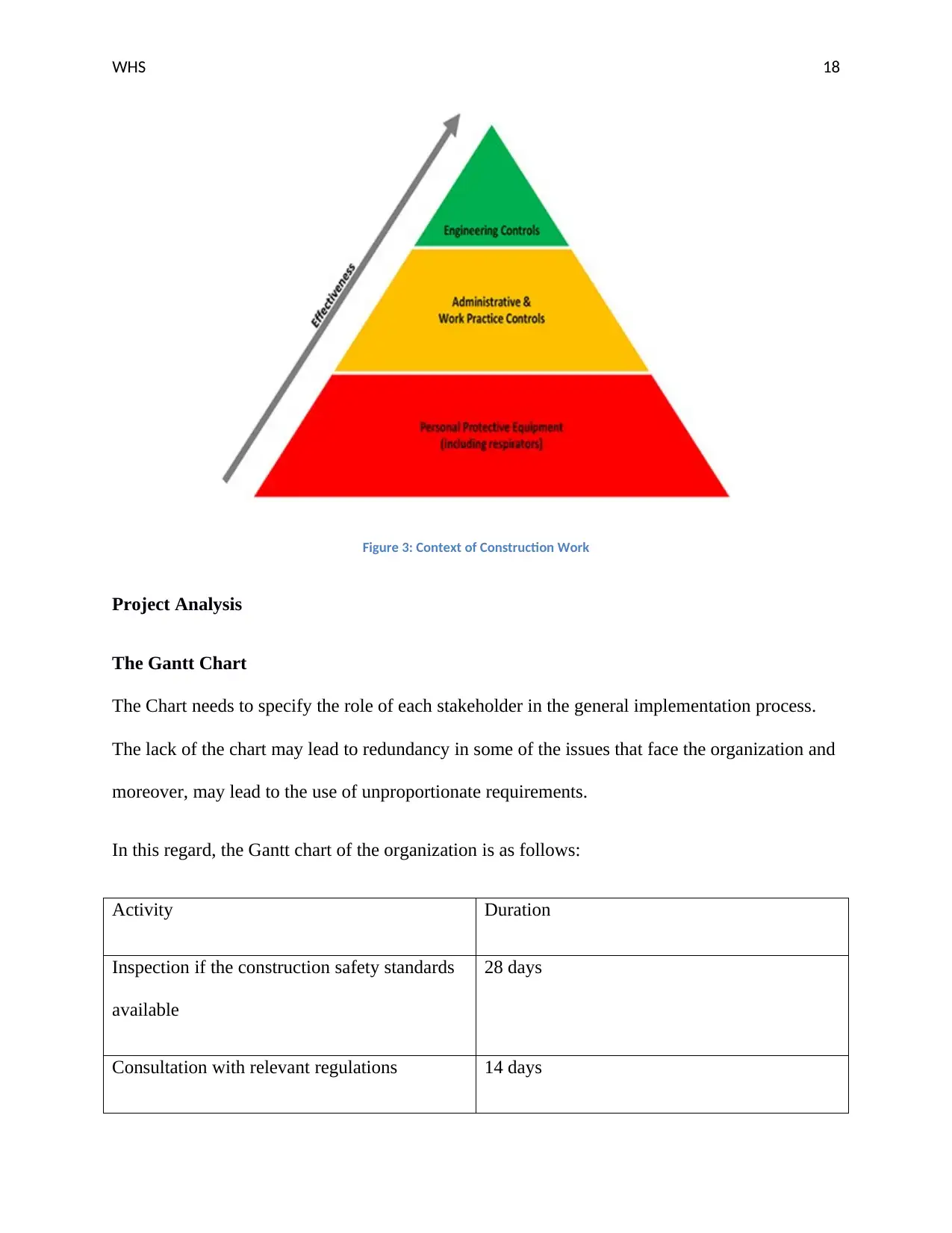
WHS 18
Figure 3: Context of Construction Work
Project Analysis
The Gantt Chart
The Chart needs to specify the role of each stakeholder in the general implementation process.
The lack of the chart may lead to redundancy in some of the issues that face the organization and
moreover, may lead to the use of unproportionate requirements.
In this regard, the Gantt chart of the organization is as follows:
Activity Duration
Inspection if the construction safety standards
available
28 days
Consultation with relevant regulations 14 days
Figure 3: Context of Construction Work
Project Analysis
The Gantt Chart
The Chart needs to specify the role of each stakeholder in the general implementation process.
The lack of the chart may lead to redundancy in some of the issues that face the organization and
moreover, may lead to the use of unproportionate requirements.
In this regard, the Gantt chart of the organization is as follows:
Activity Duration
Inspection if the construction safety standards
available
28 days
Consultation with relevant regulations 14 days
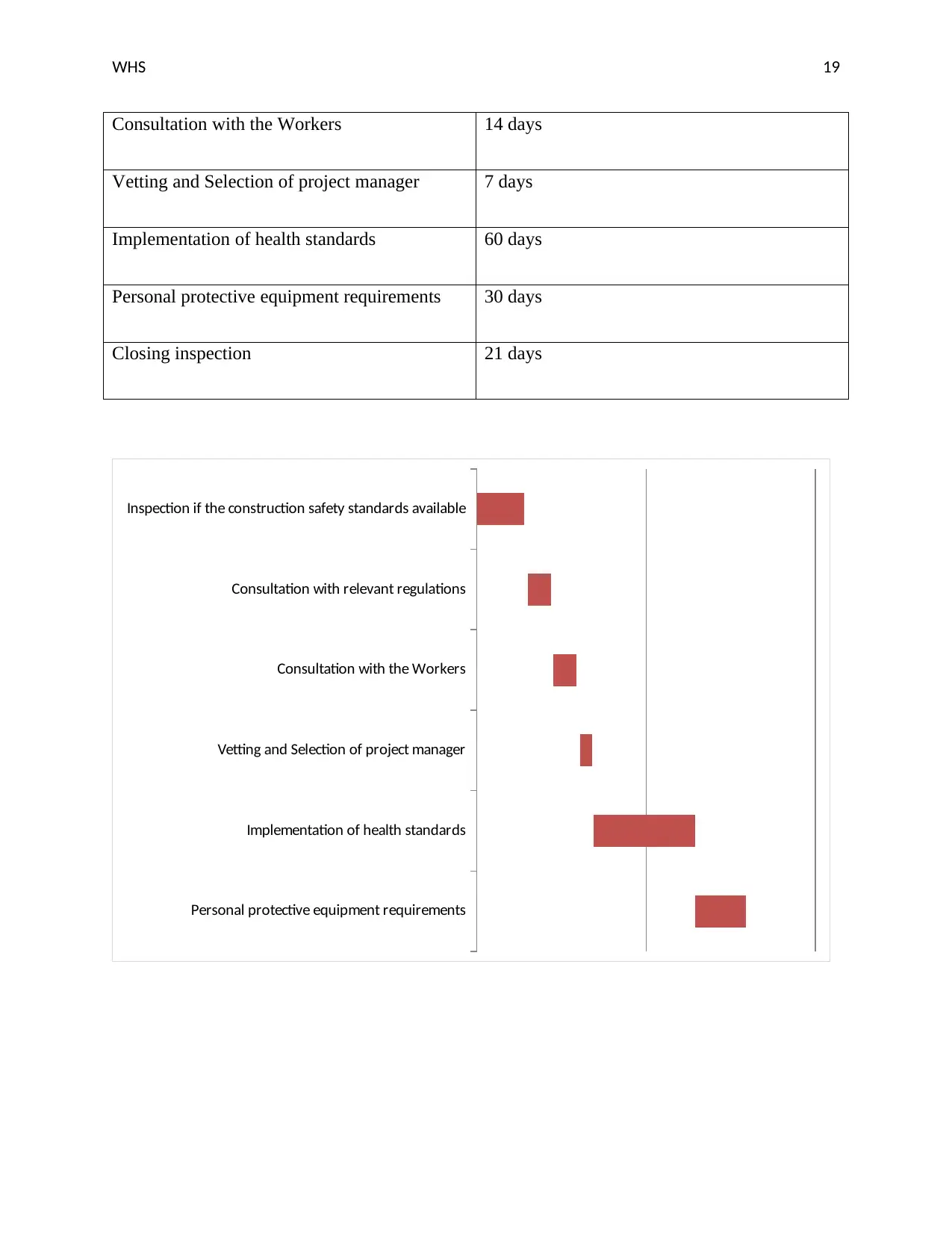
WHS 19
Consultation with the Workers 14 days
Vetting and Selection of project manager 7 days
Implementation of health standards 60 days
Personal protective equipment requirements 30 days
Closing inspection 21 days
Inspection if the construction safety standards available
Consultation with relevant regulations
Consultation with the Workers
Vetting and Selection of project manager
Implementation of health standards
Personal protective equipment requirements
Consultation with the Workers 14 days
Vetting and Selection of project manager 7 days
Implementation of health standards 60 days
Personal protective equipment requirements 30 days
Closing inspection 21 days
Inspection if the construction safety standards available
Consultation with relevant regulations
Consultation with the Workers
Vetting and Selection of project manager
Implementation of health standards
Personal protective equipment requirements
Paraphrase This Document
Need a fresh take? Get an instant paraphrase of this document with our AI Paraphraser
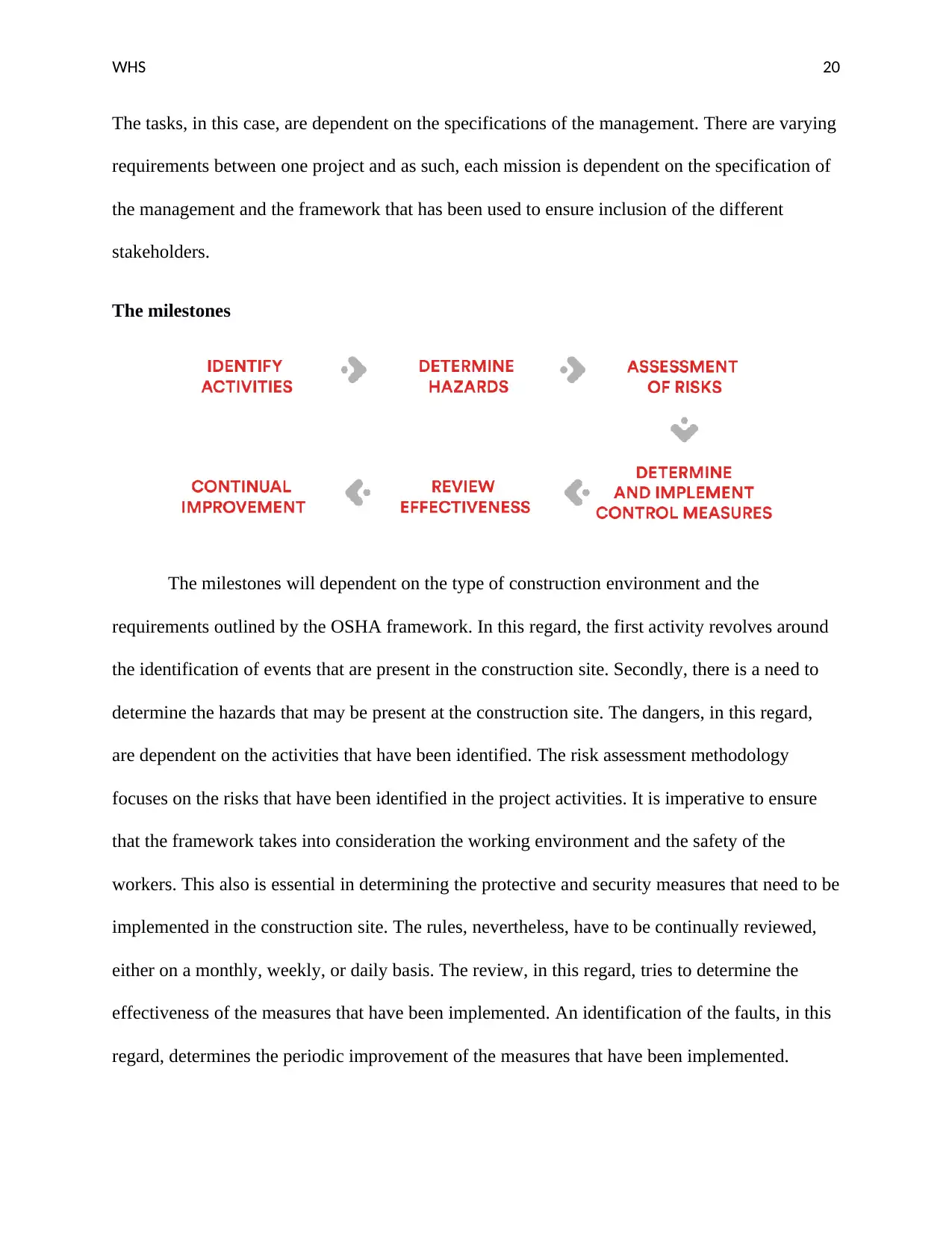
WHS 20
The tasks, in this case, are dependent on the specifications of the management. There are varying
requirements between one project and as such, each mission is dependent on the specification of
the management and the framework that has been used to ensure inclusion of the different
stakeholders.
The milestones
The milestones will dependent on the type of construction environment and the
requirements outlined by the OSHA framework. In this regard, the first activity revolves around
the identification of events that are present in the construction site. Secondly, there is a need to
determine the hazards that may be present at the construction site. The dangers, in this regard,
are dependent on the activities that have been identified. The risk assessment methodology
focuses on the risks that have been identified in the project activities. It is imperative to ensure
that the framework takes into consideration the working environment and the safety of the
workers. This also is essential in determining the protective and security measures that need to be
implemented in the construction site. The rules, nevertheless, have to be continually reviewed,
either on a monthly, weekly, or daily basis. The review, in this regard, tries to determine the
effectiveness of the measures that have been implemented. An identification of the faults, in this
regard, determines the periodic improvement of the measures that have been implemented.
The tasks, in this case, are dependent on the specifications of the management. There are varying
requirements between one project and as such, each mission is dependent on the specification of
the management and the framework that has been used to ensure inclusion of the different
stakeholders.
The milestones
The milestones will dependent on the type of construction environment and the
requirements outlined by the OSHA framework. In this regard, the first activity revolves around
the identification of events that are present in the construction site. Secondly, there is a need to
determine the hazards that may be present at the construction site. The dangers, in this regard,
are dependent on the activities that have been identified. The risk assessment methodology
focuses on the risks that have been identified in the project activities. It is imperative to ensure
that the framework takes into consideration the working environment and the safety of the
workers. This also is essential in determining the protective and security measures that need to be
implemented in the construction site. The rules, nevertheless, have to be continually reviewed,
either on a monthly, weekly, or daily basis. The review, in this regard, tries to determine the
effectiveness of the measures that have been implemented. An identification of the faults, in this
regard, determines the periodic improvement of the measures that have been implemented.
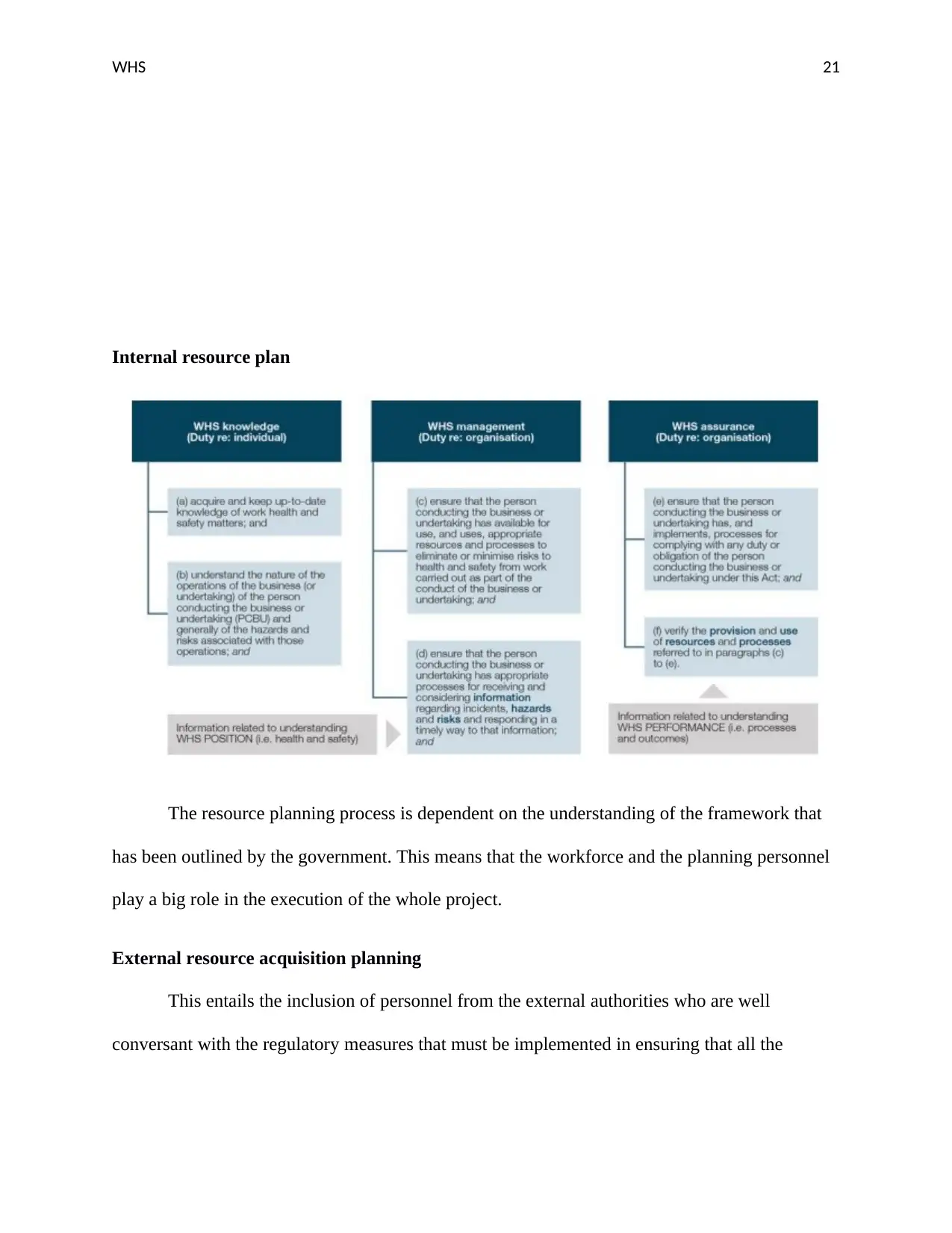
WHS 21
Internal resource plan
The resource planning process is dependent on the understanding of the framework that
has been outlined by the government. This means that the workforce and the planning personnel
play a big role in the execution of the whole project.
External resource acquisition planning
This entails the inclusion of personnel from the external authorities who are well
conversant with the regulatory measures that must be implemented in ensuring that all the
Internal resource plan
The resource planning process is dependent on the understanding of the framework that
has been outlined by the government. This means that the workforce and the planning personnel
play a big role in the execution of the whole project.
External resource acquisition planning
This entails the inclusion of personnel from the external authorities who are well
conversant with the regulatory measures that must be implemented in ensuring that all the
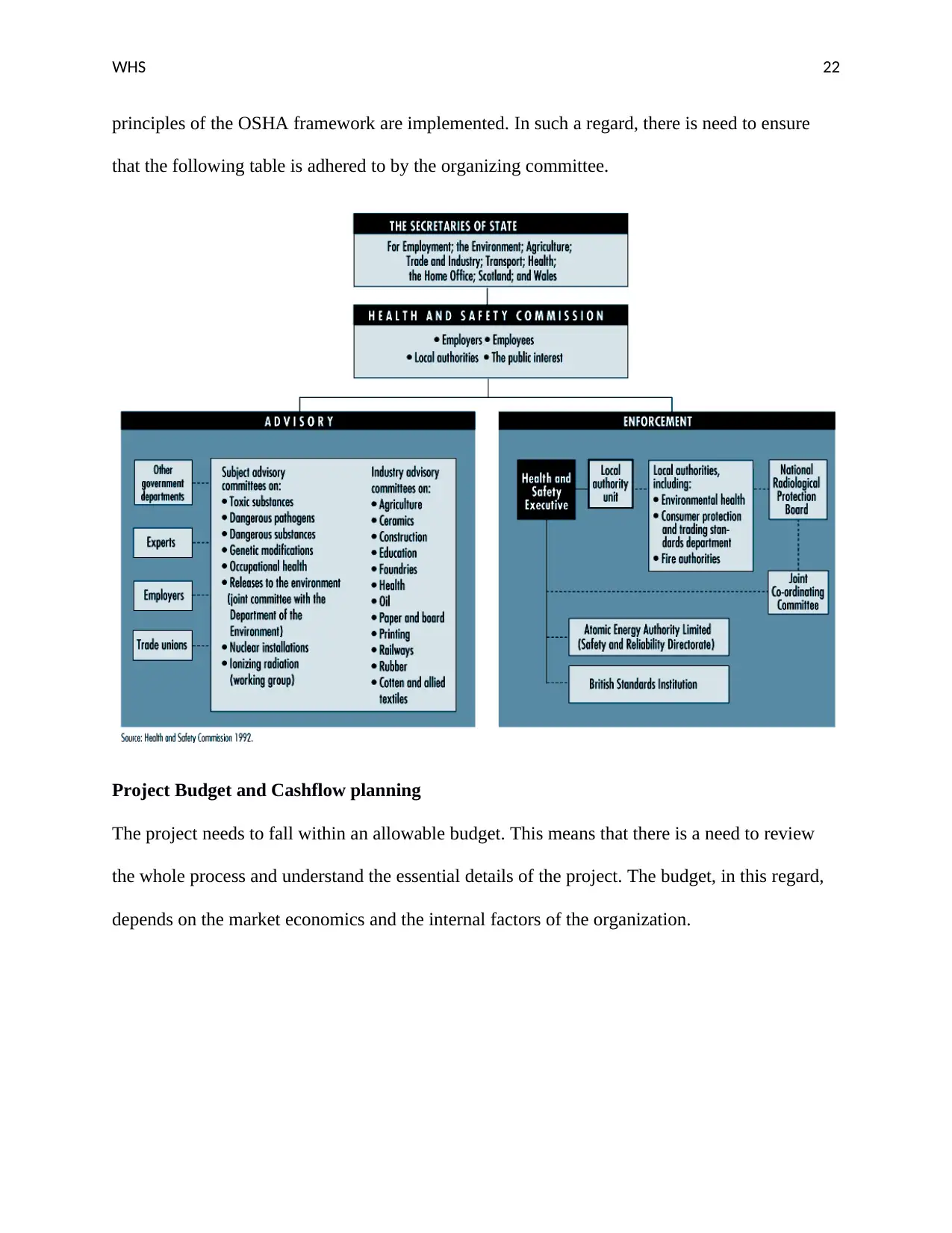
WHS 22
principles of the OSHA framework are implemented. In such a regard, there is need to ensure
that the following table is adhered to by the organizing committee.
Project Budget and Cashflow planning
The project needs to fall within an allowable budget. This means that there is a need to review
the whole process and understand the essential details of the project. The budget, in this regard,
depends on the market economics and the internal factors of the organization.
principles of the OSHA framework are implemented. In such a regard, there is need to ensure
that the following table is adhered to by the organizing committee.
Project Budget and Cashflow planning
The project needs to fall within an allowable budget. This means that there is a need to review
the whole process and understand the essential details of the project. The budget, in this regard,
depends on the market economics and the internal factors of the organization.
Secure Best Marks with AI Grader
Need help grading? Try our AI Grader for instant feedback on your assignments.
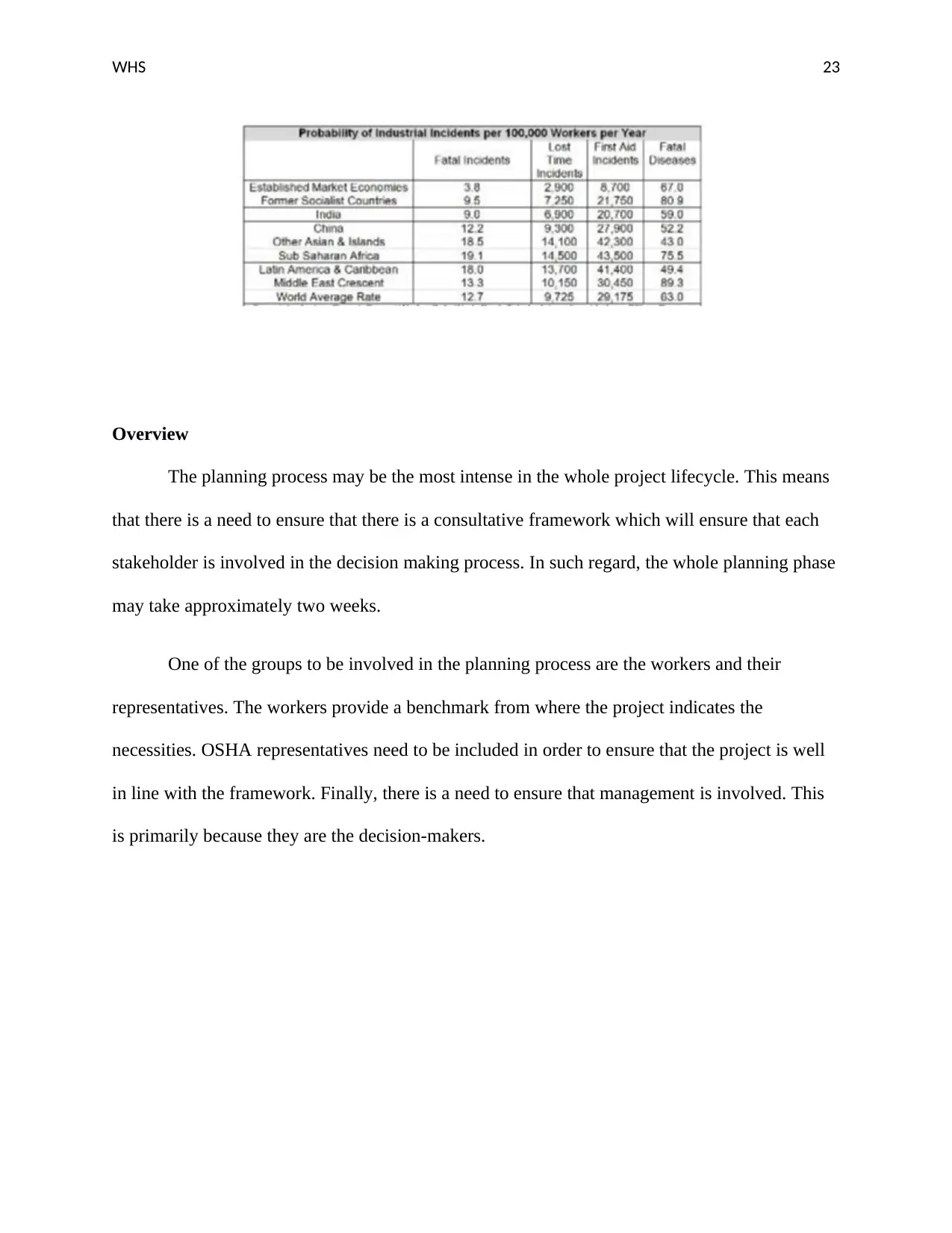
WHS 23
Overview
The planning process may be the most intense in the whole project lifecycle. This means
that there is a need to ensure that there is a consultative framework which will ensure that each
stakeholder is involved in the decision making process. In such regard, the whole planning phase
may take approximately two weeks.
One of the groups to be involved in the planning process are the workers and their
representatives. The workers provide a benchmark from where the project indicates the
necessities. OSHA representatives need to be included in order to ensure that the project is well
in line with the framework. Finally, there is a need to ensure that management is involved. This
is primarily because they are the decision-makers.
Overview
The planning process may be the most intense in the whole project lifecycle. This means
that there is a need to ensure that there is a consultative framework which will ensure that each
stakeholder is involved in the decision making process. In such regard, the whole planning phase
may take approximately two weeks.
One of the groups to be involved in the planning process are the workers and their
representatives. The workers provide a benchmark from where the project indicates the
necessities. OSHA representatives need to be included in order to ensure that the project is well
in line with the framework. Finally, there is a need to ensure that management is involved. This
is primarily because they are the decision-makers.
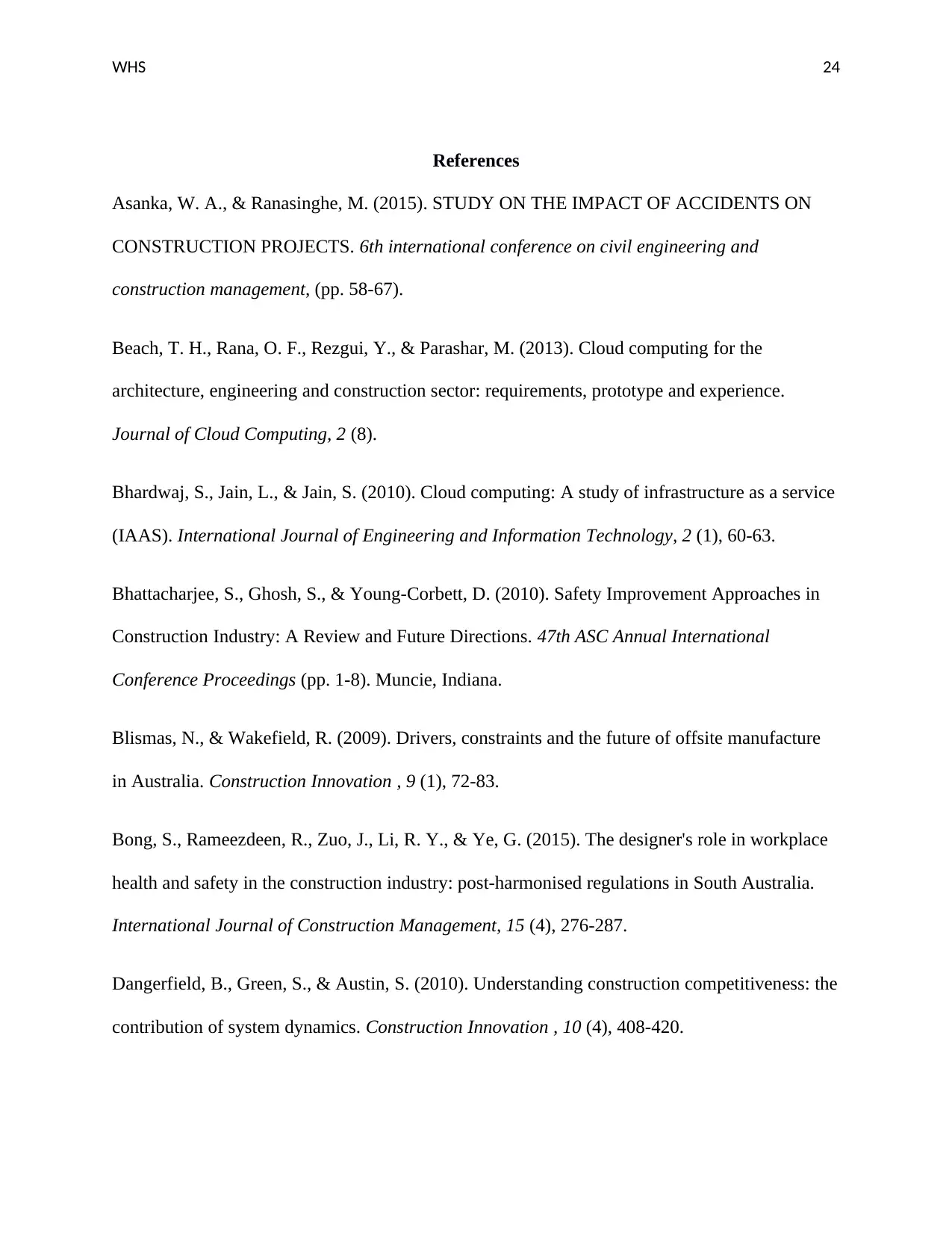
WHS 24
References
Asanka, W. A., & Ranasinghe, M. (2015). STUDY ON THE IMPACT OF ACCIDENTS ON
CONSTRUCTION PROJECTS. 6th international conference on civil engineering and
construction management, (pp. 58-67).
Beach, T. H., Rana, O. F., Rezgui, Y., & Parashar, M. (2013). Cloud computing for the
architecture, engineering and construction sector: requirements, prototype and experience.
Journal of Cloud Computing, 2 (8).
Bhardwaj, S., Jain, L., & Jain, S. (2010). Cloud computing: A study of infrastructure as a service
(IAAS). International Journal of Engineering and Information Technology, 2 (1), 60-63.
Bhattacharjee, S., Ghosh, S., & Young-Corbett, D. (2010). Safety Improvement Approaches in
Construction Industry: A Review and Future Directions. 47th ASC Annual International
Conference Proceedings (pp. 1-8). Muncie, Indiana.
Blismas, N., & Wakefield, R. (2009). Drivers, constraints and the future of offsite manufacture
in Australia. Construction Innovation , 9 (1), 72-83.
Bong, S., Rameezdeen, R., Zuo, J., Li, R. Y., & Ye, G. (2015). The designer's role in workplace
health and safety in the construction industry: post-harmonised regulations in South Australia.
International Journal of Construction Management, 15 (4), 276-287.
Dangerfield, B., Green, S., & Austin, S. (2010). Understanding construction competitiveness: the
contribution of system dynamics. Construction Innovation , 10 (4), 408-420.
References
Asanka, W. A., & Ranasinghe, M. (2015). STUDY ON THE IMPACT OF ACCIDENTS ON
CONSTRUCTION PROJECTS. 6th international conference on civil engineering and
construction management, (pp. 58-67).
Beach, T. H., Rana, O. F., Rezgui, Y., & Parashar, M. (2013). Cloud computing for the
architecture, engineering and construction sector: requirements, prototype and experience.
Journal of Cloud Computing, 2 (8).
Bhardwaj, S., Jain, L., & Jain, S. (2010). Cloud computing: A study of infrastructure as a service
(IAAS). International Journal of Engineering and Information Technology, 2 (1), 60-63.
Bhattacharjee, S., Ghosh, S., & Young-Corbett, D. (2010). Safety Improvement Approaches in
Construction Industry: A Review and Future Directions. 47th ASC Annual International
Conference Proceedings (pp. 1-8). Muncie, Indiana.
Blismas, N., & Wakefield, R. (2009). Drivers, constraints and the future of offsite manufacture
in Australia. Construction Innovation , 9 (1), 72-83.
Bong, S., Rameezdeen, R., Zuo, J., Li, R. Y., & Ye, G. (2015). The designer's role in workplace
health and safety in the construction industry: post-harmonised regulations in South Australia.
International Journal of Construction Management, 15 (4), 276-287.
Dangerfield, B., Green, S., & Austin, S. (2010). Understanding construction competitiveness: the
contribution of system dynamics. Construction Innovation , 10 (4), 408-420.
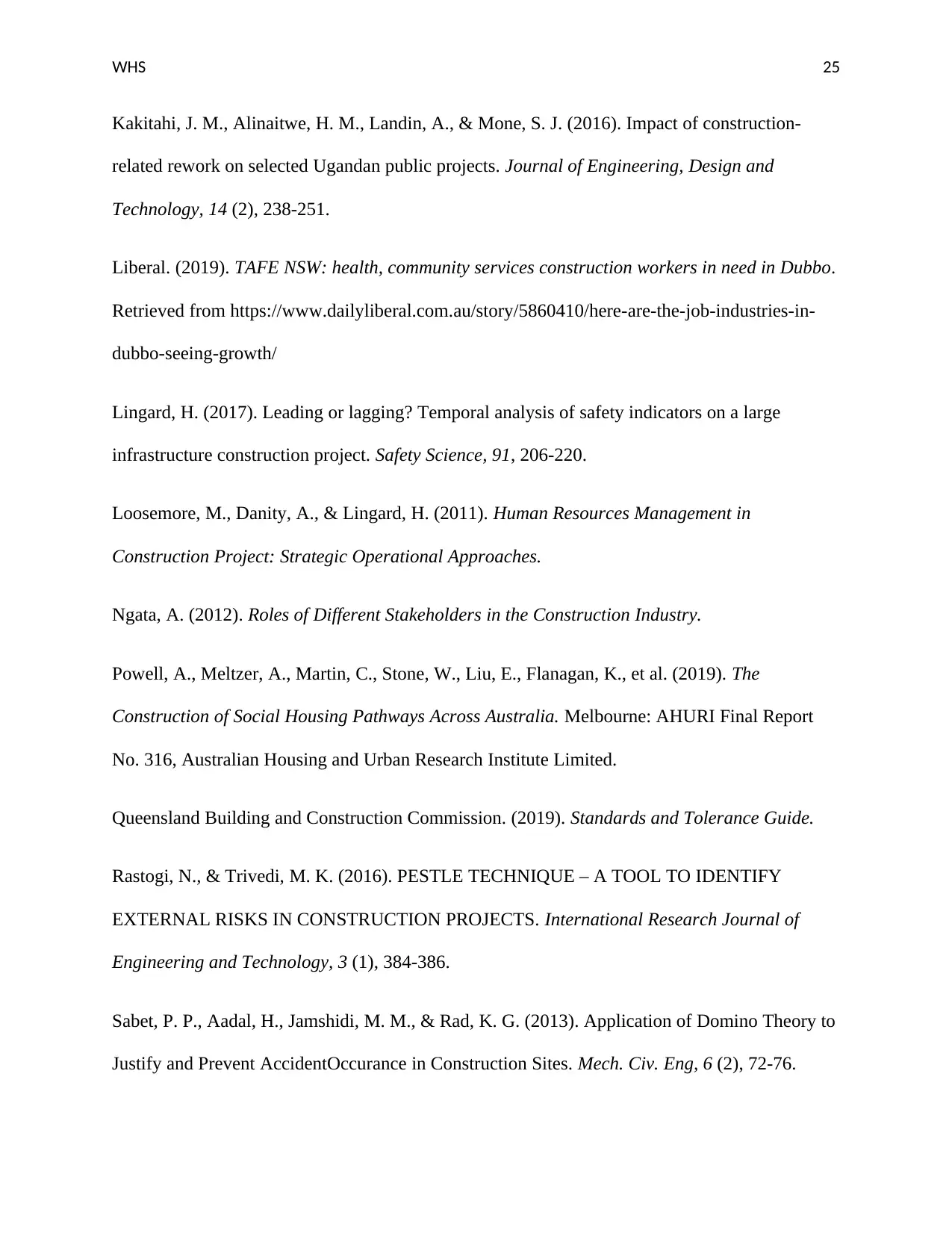
WHS 25
Kakitahi, J. M., Alinaitwe, H. M., Landin, A., & Mone, S. J. (2016). Impact of construction-
related rework on selected Ugandan public projects. Journal of Engineering, Design and
Technology, 14 (2), 238-251.
Liberal. (2019). TAFE NSW: health, community services construction workers in need in Dubbo.
Retrieved from https://www.dailyliberal.com.au/story/5860410/here-are-the-job-industries-in-
dubbo-seeing-growth/
Lingard, H. (2017). Leading or lagging? Temporal analysis of safety indicators on a large
infrastructure construction project. Safety Science, 91, 206-220.
Loosemore, M., Danity, A., & Lingard, H. (2011). Human Resources Management in
Construction Project: Strategic Operational Approaches.
Ngata, A. (2012). Roles of Different Stakeholders in the Construction Industry.
Powell, A., Meltzer, A., Martin, C., Stone, W., Liu, E., Flanagan, K., et al. (2019). The
Construction of Social Housing Pathways Across Australia. Melbourne: AHURI Final Report
No. 316, Australian Housing and Urban Research Institute Limited.
Queensland Building and Construction Commission. (2019). Standards and Tolerance Guide.
Rastogi, N., & Trivedi, M. K. (2016). PESTLE TECHNIQUE – A TOOL TO IDENTIFY
EXTERNAL RISKS IN CONSTRUCTION PROJECTS. International Research Journal of
Engineering and Technology, 3 (1), 384-386.
Sabet, P. P., Aadal, H., Jamshidi, M. M., & Rad, K. G. (2013). Application of Domino Theory to
Justify and Prevent AccidentOccurance in Construction Sites. Mech. Civ. Eng, 6 (2), 72-76.
Kakitahi, J. M., Alinaitwe, H. M., Landin, A., & Mone, S. J. (2016). Impact of construction-
related rework on selected Ugandan public projects. Journal of Engineering, Design and
Technology, 14 (2), 238-251.
Liberal. (2019). TAFE NSW: health, community services construction workers in need in Dubbo.
Retrieved from https://www.dailyliberal.com.au/story/5860410/here-are-the-job-industries-in-
dubbo-seeing-growth/
Lingard, H. (2017). Leading or lagging? Temporal analysis of safety indicators on a large
infrastructure construction project. Safety Science, 91, 206-220.
Loosemore, M., Danity, A., & Lingard, H. (2011). Human Resources Management in
Construction Project: Strategic Operational Approaches.
Ngata, A. (2012). Roles of Different Stakeholders in the Construction Industry.
Powell, A., Meltzer, A., Martin, C., Stone, W., Liu, E., Flanagan, K., et al. (2019). The
Construction of Social Housing Pathways Across Australia. Melbourne: AHURI Final Report
No. 316, Australian Housing and Urban Research Institute Limited.
Queensland Building and Construction Commission. (2019). Standards and Tolerance Guide.
Rastogi, N., & Trivedi, M. K. (2016). PESTLE TECHNIQUE – A TOOL TO IDENTIFY
EXTERNAL RISKS IN CONSTRUCTION PROJECTS. International Research Journal of
Engineering and Technology, 3 (1), 384-386.
Sabet, P. P., Aadal, H., Jamshidi, M. M., & Rad, K. G. (2013). Application of Domino Theory to
Justify and Prevent AccidentOccurance in Construction Sites. Mech. Civ. Eng, 6 (2), 72-76.
Paraphrase This Document
Need a fresh take? Get an instant paraphrase of this document with our AI Paraphraser
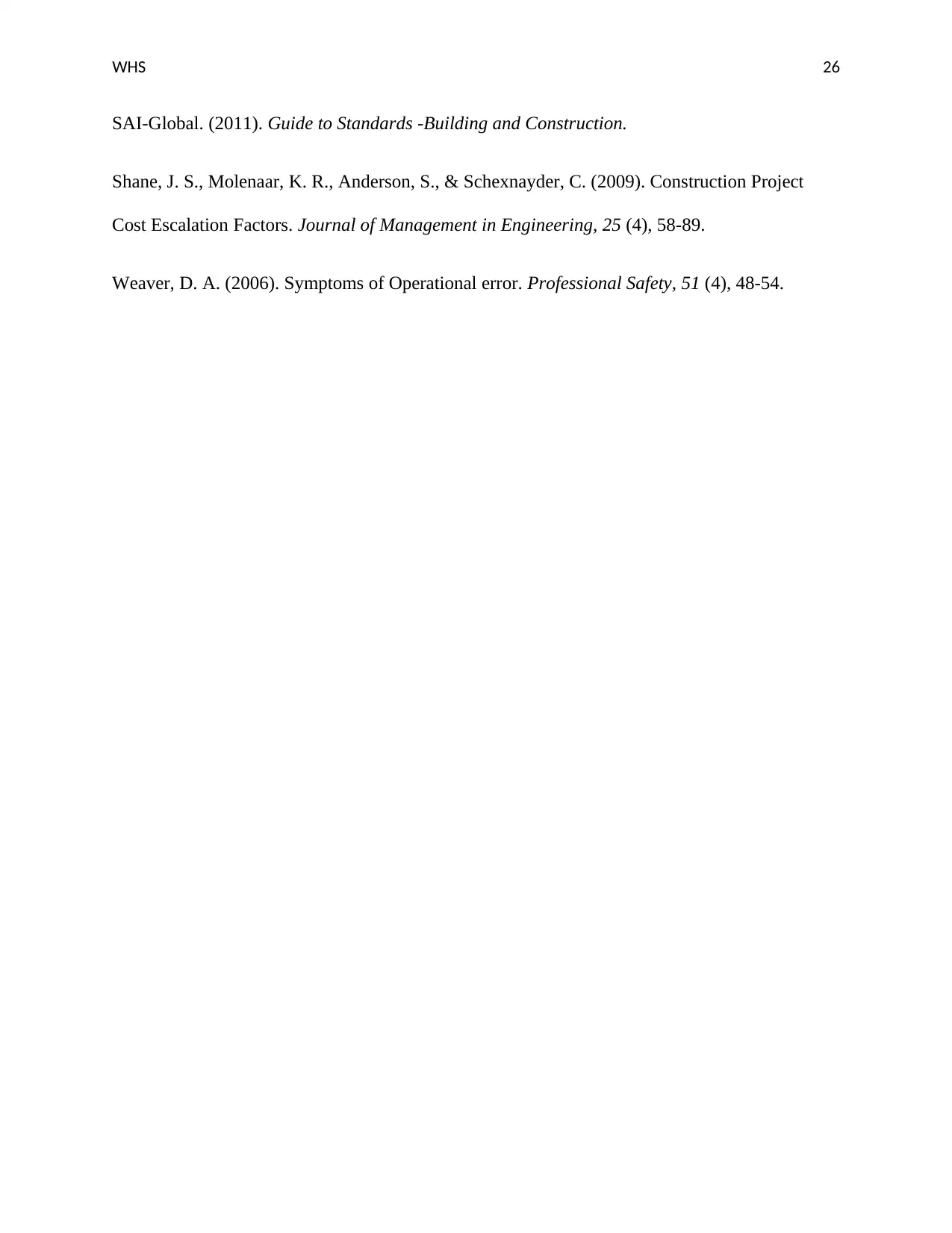
WHS 26
SAI-Global. (2011). Guide to Standards -Building and Construction.
Shane, J. S., Molenaar, K. R., Anderson, S., & Schexnayder, C. (2009). Construction Project
Cost Escalation Factors. Journal of Management in Engineering, 25 (4), 58-89.
Weaver, D. A. (2006). Symptoms of Operational error. Professional Safety, 51 (4), 48-54.
SAI-Global. (2011). Guide to Standards -Building and Construction.
Shane, J. S., Molenaar, K. R., Anderson, S., & Schexnayder, C. (2009). Construction Project
Cost Escalation Factors. Journal of Management in Engineering, 25 (4), 58-89.
Weaver, D. A. (2006). Symptoms of Operational error. Professional Safety, 51 (4), 48-54.
1 out of 26
Related Documents
Your All-in-One AI-Powered Toolkit for Academic Success.
+13062052269
info@desklib.com
Available 24*7 on WhatsApp / Email
![[object Object]](/_next/static/media/star-bottom.7253800d.svg)
Unlock your academic potential
© 2024 | Zucol Services PVT LTD | All rights reserved.




